Identification of Landslide Precursors for Early Warning of Hazards with Remote Sensing
Abstract
:1. Introduction
2. Data Collection
- Reason 1: The articles were not directly related to the literature review topic. They covered various issues, including strategies for implementing EWSs, testing measurement equipment to improve the quality of data acquired, managing and transmitting measurement data, and countering various natural disasters and phenomena;
- Reason 2: The articles were not related to landslide detection, monitoring, and prediction as defined in the article [2]. Therefore, publications in which the prediction approach was based entirely on statistical or physical models and did not involve analysis of historical data, field observations, or monitoring results were excluded from the review;
- Reason 3: The articles presented the results of studies where RST was not used.
3. RSTs: Description and Temporal Evolution of Scientific Production
3.1. SAR Overview
3.2. GB-InSAR Overview
3.3. Optical, Multispectral, and Hyperspectral Imaging Overview
3.4. LiDAR Overview
3.5. IRT Overview
3.6. Temporal Evolution of the Scientific Production
4. Application of RSTs in Landslide Precursor Detection and Measurement Data Integration in EWSs
4.1. SAR Techniques
4.2. GB-InSAR Techniques
4.3. Optical, Multispectral, and Hyperspectral Imaging Techniques
4.4. LiDAR Techniques
4.5. IRT Techniques
4.6. Measurement Data Integration in EWSs
4.6.1. Multidisciplinary Approaches
4.6.2. RS Approaches
5. Advantages and Limitations of Using RSTs to Analyze Landslide Precursors
6. Discussion
7. Summary
Author Contributions
Funding
Conflicts of Interest
References
- Wu, Q.; Qin, Y.; Tang, H.; Meng, Z.; Li, C.; Lu, S. Influence of Wetting and Drying Cycles on the Shear Behavior of Discontinuities between Two Different Rock Types with Various Surface Topographies. Acta Geotech. 2024. [Google Scholar] [CrossRef]
- Casagli, N.; Intrieri, E.; Tofani, V.; Gigli, G.; Raspini, F. Landslide Detection, Monitoring and Prediction with Remote-Sensing Techniques. Nat. Rev. Earth Environ. 2023, 4, 51–64. [Google Scholar] [CrossRef]
- Liu, S.; Segoni, S.; Raspini, F.; Yin, K.; Zhou, C.; Zhang, Y.; Casagli, N. Satellite InSAR as a New Tool for the Verification of Landslide Engineering Remedial Works at the Regional Scale: A Case Study in the Three Gorges Resevoir Area, China. Appl. Sci. 2020, 10, 6435. [Google Scholar] [CrossRef]
- Prestininzi, A.; Bianchi-Fasani, G.; Bozzano, F.; Esposito, C.; Martino, S.; Mazzanti, P.; Scarascia-Mugnozza, G. From the Refinement of Geological Models to Risk Management: The Role of Landslide Monitoring. In Landslides and Engineered Slopes: Protecting Society through Improved Understanding; Taylor & Francis Group: London, UK, 2012. [Google Scholar]
- Pecoraro, G.; Calvello, M.; Piciullo, L. Monitoring Strategies for Local Landslide Early Warning Systems. Landslides 2019, 16, 213–231. [Google Scholar] [CrossRef]
- Gian, Q.A.; Tran, D.-T.; Nguyen, D.C.; Nhu, V.H.; Tien Bui, D. Design and Implementation of Site-Specific Rainfall-Induced Landslide Early Warning and Monitoring System: A Case Study at Nam Dan Landslide (Vietnam). Geomat. Nat. Hazards Risk 2017, 8, 1978–1996. [Google Scholar] [CrossRef]
- Auflič, M.J.; Herrera, G.; Mateos, R.M.; Poyiadji, E.; Quental, L.; Severine, B.; Peternel, T.; Podolszki, L.; Calcaterra, S.; Kociu, A.; et al. Landslide Monitoring Techniques in the Geological Surveys of Europe. Landslides 2023, 20, 951–965. [Google Scholar] [CrossRef]
- Jemec Auflič, M.; Komac, M.; Šinigoj, J. Modern Remote Sensing Techniques for Monitoring Pipeline Displacements in Relation to Landslides and Other Slope Mass Movements. In Environmental Security of the European Cross-Border Energy Supply Infrastructure; Culshaw, M.G., Osipov, V.I., Booth, S.J., Victorov, A.S., Eds.; NATO Science for Peace and Security Series C: Environmental Security; Springer: Dordrecht, The Netherlands, 2015; ISBN 978-94-017-9537-1. [Google Scholar] [CrossRef]
- Michoud, C.; Bazin, S.; Blikra, L.H.; Derron, M.-H.; Jaboyedoff, M. Experiences from Site-Specific Landslide Early Warning Systems. Nat. Hazards Earth Syst. Sci. 2013, 13, 2659–2673. [Google Scholar] [CrossRef]
- Brunetti, M.T.; Melillo, M.; Gariano, S.L.; Ciabatta, L.; Brocca, L.; Amarnath, G.; Peruccacci, S. Satellite Rainfall Products Outperform Ground Observations for Landslide Prediction in India. Hydrol. Earth Syst. Sci. 2021, 25, 3267–3279. [Google Scholar] [CrossRef]
- Liu, G.; Guo, H.; Perski, Z.; Fan, J.; João Sousa, J.; Yan, S.; Tang, P. Landslide Movement Monitoring with ALOS-2 SAR Data. IOP Conf. Ser. Earth Environ. Sci. 2019, 227, 062015. [Google Scholar] [CrossRef]
- Carlà, T.; Intrieri, E.; Farina, P.; Casagli, N. A New Approach to Assess the Stability of Rock Slopes and Identify Impending Failure Conditions. In Advancing Culture of Living with Landslides; Mikos, M., Tiwari, B., Yin, Y., Sassa, K., Eds.; Springer International Publishing: Cham, Switzerland, 2017; pp. 733–739. ISBN 978-3-319-53497-8. [Google Scholar]
- Intrieri, E.; Raspini, F.; Fumagalli, A.; Lu, P.; Del Conte, S.; Farina, P.; Allievi, J.; Ferretti, A.; Casagli, N. The Maoxian Landslide as Seen from Space: Detecting Precursors of Failure with Sentinel-1 Data. Landslides 2018, 15, 123–133. [Google Scholar] [CrossRef]
- Lacroix, P.; Bièvre, G.; Pathier, E.; Kniess, U.; Jongmans, D. Use of Sentinel-2 Images for the Detection of Precursory Motions before Landslide Failures. Remote Sens. Environ. 2018, 215, 507–516. [Google Scholar] [CrossRef]
- Martín-Martín, A.; Thelwall, M.; Orduna-Malea, E.; Delgado López-Cózar, E. Google Scholar, Microsoft Academic, Scopus, Dimensions, Web of Science, and OpenCitations’ COCI: A Multidisciplinary Comparison of Coverage via Citations. Scientometrics 2021, 126, 871–906. [Google Scholar] [CrossRef] [PubMed]
- Martín-Martín, A.; Orduna-Malea, E.; Thelwall, M.; Delgado López-Cózar, E. Google Scholar, Web of Science, and Scopus: A Systematic Comparison of Citations in 252 Subject Categories. J. Informetr. 2018, 12, 1160–1177. [Google Scholar] [CrossRef]
- Orduna-Malea, E.; Martín-Martín, A.; Delgado López-Cózar, E. Google Scholar Como Una Fuente de Evaluación Científica: Una Revisión Bibliográfica Sobre Errores de La Base de Datos. Rev. Esp. Doc. Científica 2017, 40, 185. [Google Scholar] [CrossRef]
- Singh, V.K.; Singh, P.; Karmakar, M.; Leta, J.; Mayr, P. The Journal Coverage of Web of Science, Scopus and Dimensions: A Comparative Analysis. Scientometrics 2021, 126, 5113–5142. [Google Scholar] [CrossRef]
- Moher, D.; Liberati, A.; Tetzlaff, J.; Altman, D.G. The PRISMA Group Preferred Reporting Items for Systematic Reviews and Meta-Analyses: The PRISMA Statement. PLoS Med. 2009, 6, e1000097. [Google Scholar] [CrossRef] [PubMed]
- Yi, Z.; Xingmin, M.; Allesandro, N.; Tom, D.; Guan, C.; Colm, J.; Yuanxi, L.; Xiaojun, S. Characterization of Pre-Failure Deformation and Evolution of a Large Earthflow Using InSAR Monitoring and Optical Image Interpretation. Landslides 2022, 19, 35–50. [Google Scholar] [CrossRef]
- Casagli, N.; Frodella, W.; Morelli, S.; Tofani, V.; Ciampalini, A.; Intrieri, E.; Raspini, F.; Rossi, G.; Tanteri, L.; Lu, P. Spaceborne, UAV and Ground-Based Remote Sensing Techniques for Landslide Mapping, Monitoring and Early Warning. Geoenviron. Disasters 2017, 4, 9. [Google Scholar] [CrossRef]
- Zhao, C.; Lu, Z.; Zhang, Q.; de la Fuente, J. Large-Area Landslide Detection and Monitoring with ALOS/PALSAR Imagery Data over Northern California and Southern Oregon, USA. Remote Sens. Environ. 2012, 124, 348–359. [Google Scholar] [CrossRef]
- Yao, X.; Chen, Y.; Liu, D.; Zhou, Z.; Liesenberg, V.; Marcato Junior, J.; Li, J. Average-DInSAR Method for Unstable Escarpments Detection Induced by Underground Coal Mining. Int. J. Appl. Earth Obs. Geoinf. 2021, 103, 102489. [Google Scholar] [CrossRef]
- Liu, Y.; Liao, M.; Shi, X.; Zhang, L.; Cunningham, C. Potential Loess Landslide Deformation Monitoring Using L-Band SAR Interferometry. Geo-Spat. Inf. Sci. 2016, 19, 273–277. [Google Scholar] [CrossRef]
- Yin, H.Y.; Lee, C.Y.; Lin, C.W.; Chen, R.F.; Chang, C.S.; Chi, C.Y. A Nationwide Catastrophic Landslide Hazard Assessment in Taiwan. In Proceedings of the 17th European Conference on Soil Mechanics and Geotechnical Engineering (ECSMGE), Reykjavik, Iceland, 1–6 September 2019; International Society for Soil Mechanics and Geotechnical Engineering: London, UK, 2019; pp. 2549–2555. [Google Scholar] [CrossRef]
- Tzouvaras, M.; Danezis, C.; Hadjimitsis, D.G. Small Scale Landslide Detection Using Sentinel-1 Interferometric SAR Coherence. Remote Sens. 2020, 12, 1560. [Google Scholar] [CrossRef]
- Smail, T.; Abed, M.; Mebarki, A.; Lazecky, M. Earthquake-Induced Landslide Monitoring and Survey by Means of InSAR. Nat. Hazards Earth Syst. Sci. 2022, 22, 1609–1625. [Google Scholar] [CrossRef]
- Solari, L.; Raspini, F.; Del Soldato, M.; Bianchini, S.; Ciampalini, A.; Ferrigno, F.; Tucci, S.; Casagli, N. Satellite Radar Data for Back-Analyzing a Landslide Event: The Ponzano (Central Italy) Case Study. Landslides 2018, 15, 773–782. [Google Scholar] [CrossRef]
- Yin, Y.; Liu, X.; Zhao, C.; Tomás, R.; Zhang, Q.; Lu, Z.; Li, B. Multi-Dimensional and Long-Term Time Series Monitoring and Early Warning of Landslide Hazard with Improved Cross-Platform SAR Offset Tracking Method. Sci. China Technol. Sci. 2022, 65, 1891–1912. [Google Scholar] [CrossRef]
- Qu, T.; Lu, P.; Liu, C.; Wu, H.; Shao, X.; Wan, H.; Li, N.; Li, R. Hybrid-SAR Technique: Joint Analysis Using Phase-Based and Amplitude-Based Methods for the Xishancun Giant Landslide Monitoring. Remote Sens. 2016, 8, 874. [Google Scholar] [CrossRef]
- Zhu, Y.; Qiu, H.; Liu, Z.; Wang, J.; Yang, D.; Pei, Y.; Ma, S.; Du, C.; Sun, H.; Wang, L. Detecting Long-Term Deformation of a Loess Landslide from the Phase and Amplitude of Satellite SAR Images: A Retrospective Analysis for the Closure of a Tunnel Event. Remote Sens. 2021, 13, 4841. [Google Scholar] [CrossRef]
- Jia, H.; Zhang, H.; Liu, L.; Liu, G. Landslide Deformation Monitoring by Adaptive Distributed Scatterer Interferometric Synthetic Aperture Radar. Remote Sens. 2019, 11, 2273. [Google Scholar] [CrossRef]
- Wang, C.; Li, Q.; Zhu, J.; Gao, W.; Shan, X.; Song, J.; Ding, X. Formation of the 2015 Shenzhen Landslide as Observed by SAR Shape-from-Shading. Sci. Rep. 2017, 7, 43351. [Google Scholar] [CrossRef]
- Manconi, A.; Kourkouli, P.; Caduff, R.; Strozzi, T.; Loew, S. Monitoring Surface Deformation over a Failing Rock Slope with the ESA Sentinels: Insights from Moosfluh Instability, Swiss Alps. Remote Sens. 2018, 10, 672. [Google Scholar] [CrossRef]
- Wasowski, J.; Bovenga, F. Remote Sensing of Landslide Motion with Emphasis on Satellite Multitemporal Interferometry Applications. In Landslide Hazards, Risks, and Disasters; Elsevier: Amsterdam, The Netherlands, 2015; pp. 345–403. ISBN 978-0-12-396452-6. [Google Scholar]
- Lazecký, M.; Hatton, E.; González, P.J.; Hlaváčová, I.; Jiránková, E.; Dvořák, F.; Šustr, Z.; Martinovič, J. Displacements Monitoring over Czechia by IT4S1 System for Automatised Interferometric Measurements Using Sentinel-1 Data. Remote Sens. 2020, 12, 2960. [Google Scholar] [CrossRef]
- Zhang, B.; Wang, Y. An Improved Two-Step Multitemporal SAR Interferometry Method for Precursory Slope Deformation Detection Over Nanyu Landslide. IEEE Geosci. Remote Sens. Lett. 2021, 18, 592–596. [Google Scholar] [CrossRef]
- Bovenga, F.; Argentiero, I.; Refice, A.; Nutricato, R.; Nitti, D.O.; Pasquariello, G.; Spilotro, G. Assessing the Potential of Long, Multi-Temporal SAR Interferometry Time Series for Slope Instability Monitoring: Two Case Studies in Southern Italy. Remote Sens. 2022, 14, 1677. [Google Scholar] [CrossRef]
- Ouyang, C.; Zhao, W.; An, H.; Zhou, S.; Wang, D.; Xu, Q.; Li, W.; Peng, D. Early Identification and Dynamic Processes of Ridge-Top Rockslides: Implications from the Su Village Landslide in Suichang County, Zhejiang Province, China. Landslides 2019, 16, 799–813. [Google Scholar] [CrossRef]
- Yao, J.; Yao, X.; Liu, X. Landslide Detection and Mapping Based on SBAS-InSAR and PS-InSAR: A Case Study in Gongjue County, Tibet, China. Remote Sens. 2022, 14, 4728. [Google Scholar] [CrossRef]
- Shankar, H.; Singh, D.; Chauhan, P. Landslide Deformation and Temporal Prediction of Slope Failure in Himalayan Terrain Using PSInSAR and Sentinel-1 Data. Adv. Space Res. 2022, 70, 3917–3931. [Google Scholar] [CrossRef]
- Raspini, F.; Bianchini, S.; Ciampalini, A.; Del Soldato, M.; Montalti, R.; Solari, L.; Tofani, V.; Casagli, N. Persistent Scatterers Continuous Streaming for Landslide Monitoring and Mapping: The Case of the Tuscany Region (Italy). Landslides 2019, 16, 2033–2044. [Google Scholar] [CrossRef]
- Poyraz, F.; Gül, Y.; Duymaz, B. Determination of Deformations by Using the PSI Technique at a Common Dump Site of Three Different Open-Pit Marble Mines in Turkey. Turk. J. Earth Sci. 2020, 29, 1004–1016. [Google Scholar] [CrossRef]
- Dun, J.; Feng, W.; Yi, X.; Zhang, G. Monitoring the Two-Dimensional Deformation of the Old Landslide in Woda Village with Radar Interferometry Technology. IOP Conf. Ser. Earth Environ. Sci. 2021, 861, 072030. [Google Scholar] [CrossRef]
- Kuri, M.; Arora, M.K.; Bhattacharya, A.; Sharma, M.L. Microwave Remote Sensing Based Small Baseline Subset Technique for Estimation of Slope Movement in Nainital Area, India. In Proceedings of the 2017 Fourth International Conference on Image Information Processing (ICIIP), Shimla, India, 21–23 December 2017; IEEE: New York, NY, USA, 2017; pp. 1–6. [Google Scholar]
- Zhao, C.; Zhang, Q.; He, Y.; Peng, J.; Yang, C.; Kang, Y. Small-Scale Loess Landslide Monitoring with Small Baseline Subsets Interferometric Synthetic Aperture Radar Technique—Case Study of Xingyuan Landslide, Shaanxi, China. J. Appl. Remote Sens. 2016, 10, 026030. [Google Scholar] [CrossRef]
- Sepúlveda, S.A.; Alfaro, A.; Lara, M.; Carrasco, J.; Olea-Encina, P.; Rebolledo, S.; Garcés, M. An Active Large Rock Slide in the Andean Paraglacial Environment: The Yerba Loca Landslide, Central Chile. Landslides 2021, 18, 697–705. [Google Scholar] [CrossRef]
- Huang, C.; Zhou, Q.; Zhou, L.; Cao, Y. Ancient Landslide in Wanzhou District Analysis from 2015 to 2018 Based on ALOS-2 Data by QPS-InSAR. Nat. Hazards 2021, 109, 1777–1800. [Google Scholar] [CrossRef]
- Zhang, L.; Ding, X.; Lu, Z. Ground Settlement Monitoring Based on Temporarily Coherent Points between Two SAR Acquisitions. ISPRS J. Photogramm. Remote Sens. 2011, 66, 146–152. [Google Scholar] [CrossRef]
- Liu, Z.; Qiu, H.; Zhu, Y.; Liu, Y.; Yang, D.; Ma, S.; Zhang, J.; Wang, Y.; Wang, L.; Tang, B. Efficient Identification and Monitoring of Landslides by Time-Series InSAR Combining Single- and Multi-Look Phases. Remote Sens. 2022, 14, 1026. [Google Scholar] [CrossRef]
- Ciuffi, P.; Bayer, B.; Berti, M.; Franceschini, S.; Simoni, A. Deformation Detection in Cyclic Landslides Prior to Their Reactivation Using Two-Pass Satellite Interferometry. Appl. Sci. 2021, 11, 3156. [Google Scholar] [CrossRef]
- Lindsay, E.; Frauenfelder, R.; Rüther, D.; Nava, L.; Rubensdotter, L.; Strout, J.; Nordal, S. Multi-Temporal Satellite Image Composites in Google Earth Engine for Improved Landslide Visibility: A Case Study of a Glacial Landscape. Remote Sens. 2022, 14, 2301. [Google Scholar] [CrossRef]
- Sivasankar, T.; Ghosh, S.; Joshi, M. Exploitation of Optical and SAR Amplitude Imagery for Landslide Identification: A Case Study from Sikkim, Northeast India. Environ. Monit. Assess. 2021, 193, 386. [Google Scholar] [CrossRef]
- Wang, C.; Shan, W.; Guo, Y.; Hu, Z.; Jiang, H. Relative Factors of Beihei Highway’s Ground Deformation Interpretation Based on Remote-Sensing Imagery Technology. In Landslides in Cold Regions in the Context of Cli Mate Change; Environmental Science and Engineering; Springer International Publishing: Cham, Switzerland, 2014; pp. 191–204. ISBN 978-3-319-00866-0. [Google Scholar]
- Ramirez, R.; Abdullah, R.E.; Jang, W.; Choi, S.-K.; Kwon, T.-H. Satellite-Based Monitoring of an Open-Pit Mining Site Using Sentinel-1 Advanced Radar Interferometry: A Case Study of the December 21, 2020, Landslide in Toledo City, Philippines. E3S Web Conf. 2023, 415, 05020. [Google Scholar] [CrossRef]
- Hanssen, R.F. Radar Interferometry: Data Interpretation and Error Analysis; Remote Sensing and Digital Image Processing; Springer: Dordrecht, The Netherlands, 2001; Volume 2, ISBN 978-0-7923-6945-5. [Google Scholar]
- Crosetto, M.; Monserrat, O.; Cuevas-González, M.; Devanthéry, N.; Crippa, B. Persistent Scatterer Interferometry: A Review. ISPRS J. Photogramm. Remote Sens. 2016, 115, 78–89. [Google Scholar] [CrossRef]
- Casagli, N.; Morelli, S.; Frodella, W.; Intrieri, E.; Tofani, V. TXT-Tool 2.039-3.2 Ground-Based Remote Sensing Techniques for Landslides Mapping, Monitoring and Early Warning. In Landslide Dynamics: ISDR-ICL Landslide Interactive Teaching Tools; Sassa, K., Guzzetti, F., Yamagishi, H., Arbanas, Ž., Casagli, N., McSaveney, M., Dang, K., Eds.; Springer International Publishing: Cham, Switzerland, 2018; pp. 255–274. ISBN 978-3-319-57773-9. [Google Scholar]
- Liu, Z.; Xu, B.; Wang, Q.; Yu, W.; Miao, Z. Monitoring Landslide Associated with Reservoir Impoundment Using Synthetic Aperture Radar Interferometry: A Case Study of the Yalong Reservoir. Geod. Geodyn. 2022, 13, 138–150. [Google Scholar] [CrossRef]
- Solari, L.; Barra, A.; Herrera, G.; Bianchini, S.; Monserrat, O.; Béjar-Pizarro, M.; Crosetto, M.; Sarro, R.; Moretti, S. Fast Detection of Ground Motions on Vulnerable Elements Using Sentinel-1 InSAR Data. Geomat. Nat. Hazards Risk 2018, 9, 152–174. [Google Scholar] [CrossRef]
- Berti, M.; Corsini, A.; Franceschini, S.; Iannacone, J.P. Automated Classification of Persistent Scatterers Interferometry Time Series. Nat. Hazards Earth Syst. Sci. 2013, 13, 1945–1958. [Google Scholar] [CrossRef]
- Crosta, G.B.; Agliardi, F.; Rivolta, C.; Alberti, S.; Dei Cas, L. Long-Term Evolution and Early Warning Strategies for Complex Rockslides by Real-Time Monitoring. Landslides 2017, 14, 1615–1632. [Google Scholar] [CrossRef]
- Béjar-Pizarro, M.; Notti, D.; Mateos, R.M.; Ezquerro, P.; Centolanza, G.; Herrera, G.; Bru, G.; Sanabria, M.; Solari, L.; Duro, J.; et al. Mapping Vulnerable Urban Areas Affected by Slow-Moving Landslides Using Sentinel-1 InSAR Data. Remote Sens. 2017, 9, 876. [Google Scholar] [CrossRef]
- Bardi, F.; Frodella, W.; Ciampalini, A.; Bianchini, S.; Del Ventisette, C.; Gigli, G.; Fanti, R.; Moretti, S.; Basile, G.; Casagli, N. Integration between Ground Based and Satellite SAR Data in Landslide Mapping: The San Fratello Case Study. Geomorphology 2014, 223, 45–60. [Google Scholar] [CrossRef]
- Bianchini, S.; Cigna, F.; Righini, G.; Proietti, C.; Casagli, N. Landslide HotSpot Mapping by Means of Persistent Scatterer Interferometry. Environ. Earth Sci. 2012, 67, 1155–1172. [Google Scholar] [CrossRef]
- Ponziani, F.; Ciuffi, P.; Bayer, B.; Berni, N.; Franceschini, S.; Simoni, A. Regional-Scale InSAR Investigation and Landslide Early Warning Thresholds in Umbria, Italy. Eng. Geol. 2023, 327, 107352. [Google Scholar] [CrossRef]
- Casagli, N.; Catani, F.; Del Ventisette, C.; Luzi, G. Monitoring, Prediction, and Early Warning Using Ground-Based Radar Interferometry. Landslides 2010, 7, 291–301. [Google Scholar] [CrossRef]
- Karunathilake, A.; Zou, L.; Kikuta, K.; Nishimoto, M.; Sato, M. Implementation and Configuration of GB-SAR for Landslide Monitoring: Case Study in Minami-Aso, Kumamoto. Explor. Geophys. 2019, 50, 210–220. [Google Scholar] [CrossRef]
- Bozzano, F.; Mazzanti, P.; Prestininzi, A.; Scarascia Mugnozza, G. Research and Development of Advanced Technologies for Landslide Hazard Analysis in Italy. Landslides 2010, 7, 381–385. [Google Scholar] [CrossRef]
- Del Ventisette, C.; Casagli, N.; Fortuny-Guasch, J.; Tarchi, D. Ruinon Landslide (Valfurva, Italy) Activity in Relation to Rainfall by Means of GBInSAR Monitoring. Landslides 2012, 9, 497–509. [Google Scholar] [CrossRef]
- Lombardi, L.; Nocentini, M.; Frodella, W.; Nolesini, T.; Bardi, F.; Intrieri, E.; Carlà, T.; Solari, L.; Dotta, G.; Ferrigno, F.; et al. The Calatabiano Landslide (Southern Italy): Preliminary GB-InSAR Monitoring Data and Remote 3D Mapping. Landslides 2017, 14, 685–696. [Google Scholar] [CrossRef]
- Guo, Y.; Yang, Z.; Yang, Y.; Kong, Z.; Gao, C.; Tian, W. Experimental Study on Deformation Monitoring of Large Landslide in Reservoir Area of Hydropower Station Based on GB-InSAR. Adv. Civ. Eng. 2021, 2021, 5586340. [Google Scholar] [CrossRef]
- Intrieri, E.; Gigli, G.; Lombardi, L.; Raspini, F.; Salvatici, T.; Bertolini, G. Integration of Ground-Based Interferometry and Terrestrial Laser Scanning for Rockslide and Rockfall Monitoring. Rend. Online Della Soc. Geol. Ital. 2016, 41, 243–246. [Google Scholar] [CrossRef]
- Ferrigno, F.; Gigli, G.; Fanti, R.; Intrieri, E.; Casagli, N. GB-InSAR Monitoring and Observational Method for Landslide Emergency Management: The Montaguto Earthflow (AV, Italy). Nat. Hazards Earth Syst. Sci. 2017, 17, 845–860. [Google Scholar] [CrossRef]
- De Macedo, K.A.C.; Ramos, F.L.G.; Gaboardi, C.; Moreira, J.R.; Vissirini, F.; Da Costa, M.S. A Compact Ground-Based Interferometric Radar for Landslide Monitoring: The Xerém Experiment. IEEE J. Sel. Top. Appl. Earth Obs. Remote Sens. 2017, 10, 975–986. [Google Scholar] [CrossRef]
- Xiang, X.; Chen, C.; Wang, H.; Lu, H.; Zhang, H.; Chen, J. A Real-Time Processing Method for GB-SAR Monitoring Data by Using the Dynamic Kalman Filter Based on the PS Network. Landslides 2023, 20, 1639–1655. [Google Scholar] [CrossRef]
- Kristensen, L.; Blikra, L.H. Monitoring Displacement on the Mannen Rockslide in Western Norway. In Landslide Science and Practice; Margottini, C., Canuti, P., Sassa, K., Eds.; Springer: Berlin/Heidelberg, Germany, 2013; pp. 251–256. ISBN 978-3-642-31444-5. [Google Scholar] [CrossRef]
- Atzeni, C.; Barla, M.; Pieraccini, M.; Antolini, F. Early Warning Monitoring of Natural and Engineered Slopes with Ground-Based Synthetic-Aperture Radar. Rock Mech. Rock Eng. 2015, 48, 235–246. [Google Scholar] [CrossRef]
- Puniach, E.; Gruszczyński, W.; Ćwiąkała, P.; Matwij, W. Application of UAV-Based Orthomosaics for Determination of Horizontal Displacement Caused by Underground Mining. ISPRS J. Photogramm. Remote Sens. 2021, 174, 282–303. [Google Scholar] [CrossRef]
- Stumpf, A.; Malet, J.-P.; Allemand, P.; Pierrot-Deseilligny, M.; Skupinski, G. Ground-Based Multi-View Photogrammetry for the Monitoring of Landslide Deformation and Erosion. Geomorphology 2015, 231, 130–145. [Google Scholar] [CrossRef]
- Lucieer, A.; Jong, S.M.D.; Turner, D. Mapping Landslide Displacements Using Structure from Motion (SfM) and Image Correlation of Multi-Temporal UAV Photography. Prog. Phys. Geogr. Earth Environ. 2014, 38, 97–116. [Google Scholar] [CrossRef]
- Xu, Q.; Zhao, B.; Dai, K.; Dong, X.; Li, W.; Zhu, X.; Yang, Y.; Xiao, X.; Wang, X.; Huang, J.; et al. Remote Sensing for Landslide Investigations: A Progress Report from China. Eng. Geol. 2023, 321, 107156. [Google Scholar] [CrossRef]
- Lan, H.; Liu, X.; Li, L.; Li, Q.; Tian, N.; Peng, J. Remote Sensing Precursors Analysis for Giant Landslides. Remote Sens. 2022, 14, 4399. [Google Scholar] [CrossRef]
- Wang, H.; Nie, D.; Tuo, X.; Zhong, Y. Research on Crack Monitoring at the Trailing Edge of Landslides Based on Image Processing. Landslides 2020, 17, 985–1007. [Google Scholar] [CrossRef]
- Thapa, P.S.; Adhikari, B.R.; Shaw, R.; Bhattarai, D.; Yanai, S. Geomorphological Analysis and Early Warning Systems for Landslide Risk Mitigation in Nepalese Mid-Hills. Nat. Hazards 2023, 117, 1793–1812. [Google Scholar] [CrossRef]
- Ma, H.-R.; Cheng, X.; Chen, L.; Zhang, H.; Xiong, H. Automatic Identification of Shallow Landslides Based on Worldview2 Remote Sensing Images. J. Appl. Remote Sens. 2016, 10, 016008. [Google Scholar] [CrossRef]
- Guo, Y.; Li, X.; Ju, S.; Lyu, Q.; Liu, T. Utilization of 3D Laser Scanning for Stability Evaluation and Deformation Monitoring of Landslides. J. Environ. Public Health 2022, 2022, 8225322. [Google Scholar] [CrossRef]
- Lohani, B.; Ghosh, S. Airborne LiDAR Technology: A Review of Data Collection and Processing Systems. Proc. Natl. Acad. Sci. India Sect. A Phys. Sci. 2017, 87, 567–579. [Google Scholar] [CrossRef]
- Conte, G.; Kleiner, A.; Rudol, P.; Korwel, K.; Wzorek, M.; Doherty, P. Performance Evaluation of A Light-Weight Multi-Echo Lidar for Unmanned Rotorcraft Applications. Int. Arch. Photogramm. Remote Sens. Spat. Inf. Sci. 2013, XL-1/W2, 87–92. [Google Scholar] [CrossRef]
- Guerin, A.; Stock, G.M.; Radue, M.J.; Jaboyedoff, M.; Collins, B.D.; Matasci, B.; Avdievitch, N.; Derron, M.-H. Quantifying 40 Years of Rockfall Activity in Yosemite Valley with Historical Structure-from-Motion Photogrammetry and Terrestrial Laser Scanning. Geomorphology 2020, 356, 107069. [Google Scholar] [CrossRef]
- Abellán, A.; Oppikofer, T.; Jaboyedoff, M.; Rosser, N.J.; Lim, M.; Lato, M.J. Terrestrial Laser Scanning of Rock Slope Instabilities. Earth Surf. Process. Landf. 2014, 39, 80–97. [Google Scholar] [CrossRef]
- Blasone, G.; Cavalli, M.; Marchi, L.; Cazorzi, F. Monitoring Sediment Source Areas in a Debris-Flow Catchment Using Terrestrial Laser Scanning. Catena 2014, 123, 23–36. [Google Scholar] [CrossRef]
- Parenti, C.; Rossi, P.; Mancini, F.; Scorpio, V.; Grassi, F.; Ciccarese, G.; Lugli, F.; Soldati, M. Multitemporal Analysis of Slow-Moving Landslides and Channel Dynamics through Integrated Remote Sensing and In Situ Techniques. Remote Sens. 2023, 15, 3563. [Google Scholar] [CrossRef]
- Razak, K.A.; Santangelo, M.; Van Westen, C.J.; Straatsma, M.W.; De Jong, S.M. Generating an Optimal DTM from Airborne Laser Scanning Data for Landslide Mapping in a Tropical Forest Environment. Geomorphology 2013, 190, 112–125. [Google Scholar] [CrossRef]
- Borkowski, A.; Perski, Z.; Wojciechowski, T.; Jóźków, G.; Wójcik, A. Landslides Mapping in Roznow Lake Vicinity, Poland Using Airborne Laser Scanning Data. Acta Geodyn. Geomater. 2011, 8, 325–333. [Google Scholar]
- Mezaal, M.; Pradhan, B.; Rizeei, H. Improving Landslide Detection from Airborne Laser Scanning Data Using Optimized Dempster–Shafer. Remote Sens. 2018, 10, 1029. [Google Scholar] [CrossRef]
- Ventura, G.; Vilardo, G.; Terranova, C.; Sessa, E.B. Tracking and Evolution of Complex Active Landslides by Multi-Temporal Airborne LiDAR Data: The Montaguto Landslide (Southern Italy). Remote Sens. Environ. 2011, 115, 3237–3248. [Google Scholar] [CrossRef]
- Donati, D.; Stead, D.; Lato, M.; Gaib, S. Spatio-Temporal Characterization of Slope Damage: Insights from the Ten Mile Slide, British Columbia, Canada. Landslides 2020, 17, 1037–1049. [Google Scholar] [CrossRef]
- Travelletti, J.; Delacourt, C.; Malet, J.-P.; Allemand, P.; Schmittbuhl, J.; Toussaint, R. Performance of Image Correlation Techniques for Landslide Displacement Monitoring. In Landslide Science and Practice; Margottini, C., Canuti, P., Sassa, K., Eds.; Springer: Berlin/Heidelberg, Germany, 2013; pp. 217–226. ISBN 978-3-642-31444-5. [Google Scholar]
- Pfeiffer, J.; Zieher, T.; Bremer, M.; Wichmann, V.; Rutzinger, M. Derivation of Three-Dimensional Displacement Vectors from Multi-Temporal Long-Range Terrestrial Laser Scanning at the Reissenschuh Landslide (Tyrol, Austria). Remote Sens. 2018, 10, 1688. [Google Scholar] [CrossRef]
- Fey, C.; Rutzinger, M.; Wichmann, V.; Prager, C.; Bremer, M.; Zangerl, C. Deriving 3D Displacement Vectors from Multi-Temporal Airborne Laser Scanning Data for Landslide Activity Analyses. GIScience Remote Sens. 2015, 52, 437–461. [Google Scholar] [CrossRef]
- Vollmer, M. Infrared Thermal Imaging. In Computer Vision; Ikeuchi, K., Ed.; Springer International Publishing: Cham, Switzerland, 2021; pp. 666–670. ISBN 978-3-030-63415-5. [Google Scholar]
- Usamentiaga, R.; Venegas, P.; Guerediaga, J.; Vega, L.; Molleda, J.; Bulnes, F. Infrared Thermography for Temperature Measurement and Non-Destructive Testing. Sensors 2014, 14, 12305–12348. [Google Scholar] [CrossRef] [PubMed]
- Baroň, I.; Bečkovský, D.; Míča, L. Application of Infrared Thermography for Mapping Open Fractures in Deep-Seated Rockslides and Unstable Cliffs. Landslides 2014, 11, 15–27. [Google Scholar] [CrossRef]
- Liao, Z.; Hong, Y.; Wang, J.; Fukuoka, H.; Sassa, K.; Karnawati, D.; Fathani, F. Prototyping an Experimental Early Warning System for Rainfall-Induced Landslides in Indonesia Using Satellite Remote Sensing and Geospatial Datasets. Landslides 2010, 7, 317–324. [Google Scholar] [CrossRef]
- Li, W.; Zhan, W.; Lu, H.; Xu, Q.; Pei, X.; Wang, D.; Huang, R.; Ge, D. Precursors to Large Rockslides Visible on Optical Remote-Sensing Images and Their Implications for Landslide Early Detection. Landslides 2023, 20, 1–12. [Google Scholar] [CrossRef]
- Hungr, O.; Leroueil, S.; Picarelli, L. The Varnes Classification of Landslide Types, an Update. Landslides 2014, 11, 167–194. [Google Scholar] [CrossRef]
- Frodella, W.; Ciampalini, A.; Gigli, G.; Lombardi, L.; Raspini, F.; Nocentini, M.; Scardigli, C.; Casagli, N. Synergic Use of Satellite and Ground Based Remote Sensing Methods for Monitoring the San Leo Rock Cliff (Northern Italy). Geomorphology 2016, 264, 80–94. [Google Scholar] [CrossRef]
- Jacquemart, M.; Tiampo, K. Leveraging Time Series Analysis of Radar Coherence and Normalized Difference Vegetation Index Ratios to Characterize Pre-Failure Activity of the Mud Creek Landslide, California. Nat. Hazards Earth Syst. Sci. 2021, 21, 629–642. [Google Scholar] [CrossRef]
- Tzouvaras, M. Statistical Time-Series Analysis of Interferometric Coherence from Sentinel-1 Sensors for Landslide Detection and Early Warning. Sensors 2021, 21, 6799. [Google Scholar] [CrossRef] [PubMed]
- Liu, B.; He, K.; Han, M.; Hu, X.; Ma, G.; Wu, M. Application of UAV and GB-SAR in Mechanism Research and Monitoring of Zhonghaicun Landslide in Southwest China. Remote Sens. 2021, 13, 1653. [Google Scholar] [CrossRef]
- Deguchi, T.; Sugiyama, T.; Kishimoto, M. Landslide Monitoring by Using Ground-Based Millimeter Wave Radar System. In Proceedings of the 17th European Conference on Soil Mechanics and Geotechnical Engineering (ECSMGE), Reykjavik, Iceland, 1–6 September 2019; International Society for Soil Mechanics and Geotechnical Engineering: London, UK, 2019; pp. 627–632. [Google Scholar] [CrossRef]
- Turner, D.; Lucieer, A.; De Jong, S. Time Series Analysis of Landslide Dynamics Using an Unmanned Aerial Vehicle (UAV). Remote Sens. 2015, 7, 1736–1757. [Google Scholar] [CrossRef]
- Pellicani, R.; Argentiero, I.; Manzari, P.; Spilotro, G.; Marzo, C.; Ermini, R.; Apollonio, C. UAV and Airborne LiDAR Data for Interpreting Kinematic Evolution of Landslide Movements: The Case Study of the Montescaglioso Landslide (Southern Italy). Geosciences 2019, 9, 248. [Google Scholar] [CrossRef]
- Huang, R.; Jiang, L.; Shen, X.; Dong, Z.; Zhou, Q.; Yang, B.; Wang, H. An Efficient Method of Monitoring Slow-Moving Landslides with Long-Range Terrestrial Laser Scanning: A Case Study of the Dashu Landslide in the Three Gorges Reservoir Region, China. Landslides 2019, 16, 839–855. [Google Scholar] [CrossRef]
- Kromer, R.; Lato, M.; Hutchinson, D.J.; Gauthier, D.; Edwards, T. Managing Rockfall Risk through Baseline Monitoring of Precursors Using a Terrestrial Laser Scanner. Can. Geotech. J. 2017, 54, 953–967. [Google Scholar] [CrossRef]
- Sun, J.; Yuan, G.; Song, L.; Zhang, H. Unmanned Aerial Vehicles (UAVs) in Landslide Investigation and Monitoring: A Review. Drones 2024, 8, 30. [Google Scholar] [CrossRef]
- Deligiannakis, G.; Pallikarakis, A.; Papanikolaou, I.; Alexiou, S.; Reicherter, K. Detecting and Monitoring Early Post-Fire Sliding Phenomena Using UAV–SfM Photogrammetry and t-LiDAR-Derived Point Clouds. Fire 2021, 4, 87. [Google Scholar] [CrossRef]
- Frodella, W.; Gigli, G.; Morelli, S.; Lombardi, L.; Casagli, N. Landslide Mapping and Characterization through Infrared Thermography (IRT): Suggestions for a Methodological Approach from Some Case Studies. Remote Sens. 2017, 9, 1281. [Google Scholar] [CrossRef]
- Costantini, M.; Minati, F.; Trillo, F.; Ferretti, A.; Novali, F.; Passera, E.; Dehls, J.; Larsen, Y.; Marinkovic, P.; Eineder, M.; et al. European Ground Motion Service (EGMS). In Proceedings of the 2021 IEEE International Geoscience and Remote Sensing Symposium IGARSS, Brussels, Belgium, 11–16 July 2021; IEEE: New York, NY, USA, 2021; pp. 3293–3296. [Google Scholar] [CrossRef]
- Bentley, M.J.; Foster, J.M.; Potvin, J.J.; Bevan, G.; Sharp, J.; Woeller, D.J.; Take, W.A. Surface Displacement Expression of Progressive Failure in a Sensitive Clay Landslide Observed with Long-Term UAV Monitoring. Landslides 2023, 20, 531–546. [Google Scholar] [CrossRef]
- Lacroix, P.; Huanca, J.; Albinez, L.; Taipe, E. Precursory Motion and Time-Of-Failure Prediction of the Achoma Landslide, Peru, From High Frequency PlanetScope Satellites. Geophys. Res. Lett. 2023, 50, e2023GL105413. [Google Scholar] [CrossRef]
- Jiao, Q.; Jiang, W.; Qian, H.; Li, Q. Research on Characteristics and Failure Mechanism of Guizhou Shuicheng Landslide Based on InSAR and UAV Data. Nat. Hazards Res. 2022, 2, 17–24. [Google Scholar] [CrossRef]
- Liu, S.; Wang, H.; Huang, J.; Wu, L. High-Resolution Remote Sensing Image-Based Extensive Deformation-Induced Landslide Displacement Field Monitoring Method. Int. J. Coal Sci. Technol. 2015, 2, 170–177. [Google Scholar] [CrossRef]
- Travelletti, J.; Delacourt, C.; Allemand, P.; Malet, J.-P.; Schmittbuhl, J.; Toussaint, R.; Bastard, M. Correlation of Multi-Temporal Ground-Based Optical Images for Landslide Monitoring: Application, Potential and Limitations. ISPRS J. Photogramm. Remote Sens. 2012, 70, 39–55. [Google Scholar] [CrossRef]
- Yang, W.; Liu, L.; Shi, P. Detecting Precursors of an Imminent Landslide along the Jinsha River. Nat. Hazards Earth Syst. Sci. 2020, 20, 3215–3224. [Google Scholar] [CrossRef]
- Qi, W.; Yang, W.; He, X.; Xu, C. Detecting Chamoli Landslide Precursors in the Southern Himalayas Using Remote Sensing Data. Landslides 2021, 18, 3449–3456. [Google Scholar] [CrossRef]
- Khan, M.W.; Dunning, S.; Bainbridge, R.; Martin, J.; Diaz-Moreno, A.; Torun, H.; Jin, N.; Woodward, J.; Lim, M. Low-Cost Automatic Slope Monitoring Using Vector Tracking Analyses on Live-Streamed Time-Lapse Imagery. Remote Sens. 2021, 13, 893. [Google Scholar] [CrossRef]
- Bernardo, E.; Barrile, V.; Fotia, A. Innovative UAV Methods for Intelligent Landslide Monitoring. In Proceedings of the International Conference of Young Professionals «GeoTerrace-2020», Lviv, Ukraine, 7–9 December 2020; European Association of Geoscientists & Engineers: Bunnik, The Netherlands, 2020; pp. 1–5. [Google Scholar]
- Bernardo, E.; Palamara, R.; Boima, R. UAV and Soft Computing Methodology for Monitoring Landslide Areas (Susceptibility to Landslides and Early Warning). WSEAS Trans. Environ. Dev. 2021, 17, 490–501. [Google Scholar] [CrossRef]
- Xie, M.; Zhao, W.; Ju, N.; He, C.; Huang, H.; Cui, Q. Landslide Evolution Assessment Based on InSAR and Real-Time Monitoring of a Large Reactivated Landslide, Wenchuan, China. Eng. Geol. 2020, 277, 105781. [Google Scholar] [CrossRef]
- Kristensen, L.; Czekirda, J.; Penna, I.; Etzelmüller, B.; Nicolet, P.; Pullarello, J.S.; Blikra, L.H.; Skrede, I.; Oldani, S.; Abellan, A. Movements, Failure and Climatic Control of the Veslemannen Rockslide, Western Norway. Landslides 2021, 18, 1963–1980. [Google Scholar] [CrossRef]
- Fan, X.; Xu, Q.; Alonso-Rodriguez, A.; Subramanian, S.S.; Li, W.; Zheng, G.; Dong, X.; Huang, R. Successive Landsliding and Damming of the Jinsha River in Eastern Tibet, China: Prime Investigation, Early Warning, and Emergency Response. Landslides 2019, 16, 1003–1020. [Google Scholar] [CrossRef]
- Guilhot, D.; Martinez Del Hoyo, T.; Bartoli, A.; Ramakrishnan, P.; Leemans, G.; Houtepen, M.; Salzer, J.; Metzger, J.S.; Maknavicius, G. Internet-of-Things-Based Geotechnical Monitoring Boosted by Satellite InSAR Data. Remote Sens. 2021, 13, 2757. [Google Scholar] [CrossRef]
- Bian, S.; Chen, G.; Zeng, R.; Meng, X.; Jin, J.; Lin, L.; Zhang, Y.; Shi, W. Post-Failure Evolution Analysis of an Irrigation-Induced Loess Landslide Using Multiple Remote Sensing Approaches Integrated with Time-Lapse ERT Imaging: Lessons from Heifangtai, China. Landslides 2022, 19, 1179–1197. [Google Scholar] [CrossRef]
- Svennevig, K.; Dahl-Jensen, T.; Keiding, M.; Merryman Boncori, J.P.; Larsen, T.B.; Salehi, S.; Munck Solgaard, A.; Voss, P.H. Evolution of Events before and after the 17 June 2017 Rock Avalanche at Karrat Fjord, West Greenland—A Multidisciplinary Approach to Detecting and Locating Unstable Rock Slopes in a Remote Arctic Area. Earth Surf. Dyn. 2020, 8, 1021–1038. [Google Scholar] [CrossRef]
- Demurtas, V.; Emanuele Orru, P.; Deiana, G. Active Lateral Spreads Monitoring System in East-Central Sardinia. Eur. J. Remote Sens. 2022, 56, 2161418. [Google Scholar] [CrossRef]
- Keuschnig, M.; Schober, A.; Delleske, R.; Brandner, K.; Höfer-Öllinger, G. Scale-Oriented Landslide Monitoring and Early Warning System for Uranium Legacy Complexes in Mailuu Suu, Kyrgyzstan. Geomech. Tunn. 2021, 14, 47–53. [Google Scholar] [CrossRef]
- Ciampalini, A.; Farina, P.; Lombardi, L.; Nocentini, M.; Taurino, V.; Guidi, R.; Pina, F.D.; Tavarini, D. Integration of Satellite InSAR with a Wireless Network of Geotechnical Sensors for Slope Monitoring in Urban Areas: The Pariana Landslide Case (Massa, Italy). Remote Sens. 2021, 13, 2534. [Google Scholar] [CrossRef]
- Xiao, T.; Huang, W.; Deng, Y.; Tian, W.; Sha, Y. Long-Term and Emergency Monitoring of Zhongbao Landslide Using Space-Borne and Ground-Based InSAR. Remote Sens. 2021, 13, 1578. [Google Scholar] [CrossRef]
- Meng, Q.; Xu, Q.; Wang, B.; Li, W.; Peng, Y.; Peng, D.; Qi, X.; Zhou, D. Monitoring the Regional Deformation of Loess Landslides on the Heifangtai Terrace Using the Sentinel-1 Time Series Interferometry Technique. Nat. Hazards 2019, 98, 485–505. [Google Scholar] [CrossRef]
- Catani, F.; Canuti, P.; Casagli, N. The Use of Radar Interferometry in Landslide Monitoring. In Landslides in Cold Regions in the Context of Climate Change; Shan, W., Guo, Y., Wang, F., Marui, H., Strom, A., Eds.; Environmental Science and Engineering; Springer International Publishing: Cham, Switzerland, 2014; pp. 177–190. ISBN 978-3-319-00866-0. [Google Scholar]
- Zheng, X.; Yang, X.; Ma, H.; Ren, G.; Yu, Z.; Yang, F.; Zhang, H.; Gao, W. Integrative Landslide Emergency Monitoring Scheme Based on GB-INSAR Interferometry, Terrestrial Laser Scanning and UAV Photography. J. Phys. Conf. Ser. 2019, 1213, 052069. [Google Scholar] [CrossRef]
- Hermle, D.; Keuschnig, M.; Hartmeyer, I.; Delleske, R.; Krautblatter, M. Timely Prediction Potential of Landslide Early Warning Systems with Multispectral Remote Sensing: A Conceptual Approach Tested in the Sattelkar, Austria. Nat. Hazards Earth Syst. Sci. 2021, 21, 2753–2772. [Google Scholar] [CrossRef]
- Thirugnanam, H.; Uhlemann, S.; Reghunadh, R.; Ramesh, M.V.; Rangan, V.P. Review of Landslide Monitoring Techniques With IoT Integration Opportunities. IEEE J. Sel. Top. Appl. Earth Obs. Remote Sens. 2022, 15, 5317–5338. [Google Scholar] [CrossRef]
- Manconi, A. How Phase Aliasing Limits Systematic Space-Borne DInSAR Monitoring and Failure Forecast of Alpine Landslides. Eng. Geol. 2021, 287, 106094. [Google Scholar] [CrossRef]
- Chae, B.-G.; Park, H.-J.; Catani, F.; Simoni, A.; Berti, M. Landslide Prediction, Monitoring and Early Warning: A Concise Review of State-of-the-Art. Geosci. J. 2017, 21, 1033–1070. [Google Scholar] [CrossRef]
- Xiang, X.; Chen, C.; Wang, H.; Xing, C.; Chen, J.; Zhu, H. An Improved Method of GB-SAR Phase Unwrapping for Landslide Monitoring. Front. Earth Sci. 2022, 10, 973320. [Google Scholar] [CrossRef]
- Ma, D.; Li, Y.; Cai, J.; Li, B.; Liu, Y.; Chen, X. Real-Time Diagnosis of Island Landslides Based on GB-RAR. J. Mar. Sci. Eng. 2020, 8, 192. [Google Scholar] [CrossRef]
- Cosentino, A.; Marmoni, G.M.; Fiorucci, M.; Mazzanti, P.; Scarascia Mugnozza, G.; Esposito, C. Optical and Thermal Image Processing for Monitoring Rainfall Triggered Shallow Landslides: Insights from Analogue Laboratory Experiments. Remote Sens. 2023, 15, 5577. [Google Scholar] [CrossRef]
- Li, M.; Zhang, L.; Ding, C.; Li, W.; Luo, H.; Liao, M.; Xu, Q. Retrieval of Historical Surface Displacements of the Baige Landslide from Time-Series SAR Observations for Retrospective Analysis of the Collapse Event. Remote Sens. Environ. 2020, 240, 111695. [Google Scholar] [CrossRef]
- Moretto, S.; Bozzano, F.; Esposito, C.; Mazzanti, P.; Rocca, A. Assessment of Landslide Pre-Failure Monitoring and Forecasting Using Satellite SAR Interferometry. Geosciences 2017, 7, 36. [Google Scholar] [CrossRef]
- Schwarz, K.; Heitkötter, J.; Heil, J.; Marschner, B.; Stumpe, B. The Potential of Active and Passive Infrared Thermography for Identifying Dynamics of Soil Moisture and Microbial Activity at High Spatial and Temporal Resolution. Geoderma 2018, 327, 119–129. [Google Scholar] [CrossRef]
- Mengen, D.; Montzka, C.; Jagdhuber, T.; Fluhrer, A.; Brogi, C.; Baum, S.; Schüttemeyer, D.; Bayat, B.; Bogena, H.; Coccia, A.; et al. The SARSense Campaign: Air- and Space-Borne C- and L-Band SAR for the Analysis of Soil and Plant Parameters in Agriculture. Remote Sens. 2021, 13, 825. [Google Scholar] [CrossRef]
- Tomás, R.; Zeng, Q.; Lopez-Sanchez, J.M.; Zhao, C.; Li, Z.; Liu, X.; Navarro-Hernández, M.I.; Hu, L.; Luo, J.; Díaz, E.; et al. Advances on the Investigation of Landslides by Space-Borne Synthetic Aperture Radar Interferometry. Geo-Spat. Inf. Sci. 2023, 27, 602–623. [Google Scholar] [CrossRef]
- Shi, X.; Zhang, L.; Liao, M.; Balz, T. Landslide Monitoring in Three Gorges Area by Joint Use of Phase Based and Amplitude Based Methods. In Proceedings of the Proceedings of Fringe 2015: Advances in the Science and Applications of SAR Interferometry and Sentinel-1 InSAR Workshop, Frascati, Italy, 23–27 March 2015; European Space Agency: Paris, France, 2015. [Google Scholar]
- Deguchi, T.; Sugiyama, T.; Kishimoto, M. On the Development of Ground-Based and Drone-Borne Radar System. In Recent Research on Engineering Geology and Geological Engineering, Proceedings of the 2nd GeoMEast International Congress and Exhibition on Sustainable Civil Infrastructures, Egypt 2018—The Official International Congress of the Soil-Structure Interaction Group in Egypt (SSIGE), Cairo, Egypt, 24–28 November 2018; Wasowski, J., Dijkstra, T., Eds.; Springer International Publishing: Cham, Switzerland, 2019; ISBN 978-3-030-02031-6. [Google Scholar]
- Zheng, X.; He, G.; Wang, S.; Wang, Y.; Wang, G.; Yang, Z.; Yu, J.; Wang, N. Comparison of Machine Learning Methods for Potential Active Landslide Hazards Identification with Multi-Source Data. ISPRS Int. J. Geo-Inf. 2021, 10, 253. [Google Scholar] [CrossRef]
- Zhang, T.; Zhang, W.; Cao, D.; Yi, Y.; Wu, X. A New Deep Learning Neural Network Model for the Identification of InSAR Anomalous Deformation Areas. Remote Sens. 2022, 14, 2690. [Google Scholar] [CrossRef]
- Nava, L.; Carraro, E.; Reyes-Carmona, C.; Puliero, S.; Bhuyan, K.; Rosi, A.; Monserrat, O.; Floris, M.; Meena, S.R.; Galve, J.P.; et al. Landslide Displacement Forecasting Using Deep Learning and Monitoring Data across Selected Sites. Landslides 2023, 20, 2111–2129. [Google Scholar] [CrossRef]
- Thiebes, B.; Glade, T. Landslide Early Warning Systems—Fundamental Concepts and Innovative Applications. In Landslides and Engineered Slopes. Experience, Theory and Practice, Proceedings of the 12th International Symposium on Landslides, Naples, Italy, 12–19 June 2016; CRC Press: Boca Raton, FL, USA, 2016; pp. 1903–1911. [Google Scholar]
- Catani, F. Landslide Detection by Deep Learning of Non-Nadiral and Crowdsourced Optical Images. Landslides 2021, 18, 1025–1044. [Google Scholar] [CrossRef]
- Vassileva, M.; Motagh, M.; Roessner, S.; Xia, Z. Reactivation of an Old Landslide in North–Central Iran Following Reservoir Impoundment: Results from Multisensor Satellite Time-Series Analysis. Eng. Geol. 2023, 327, 107337. [Google Scholar] [CrossRef]
- Hussain, Y.; Schlögel, R.; Innocenti, A.; Hamza, O.; Iannucci, R.; Martino, S.; Havenith, H.-B. Review on the Geophysical and UAV-Based Methods Applied to Landslides. Remote Sens. 2022, 14, 4564. [Google Scholar] [CrossRef]
- Fang, K.; Dong, A.; Tang, H.; An, P.; Wang, Q.; Jia, S.; Zhang, B. Development of an Easy-Assembly and Low-Cost Multismartphone Photogrammetric Monitoring System for Rock Slope Hazards. Int. J. Rock Mech. Min. Sci. 2024, 174, 105655. [Google Scholar] [CrossRef]
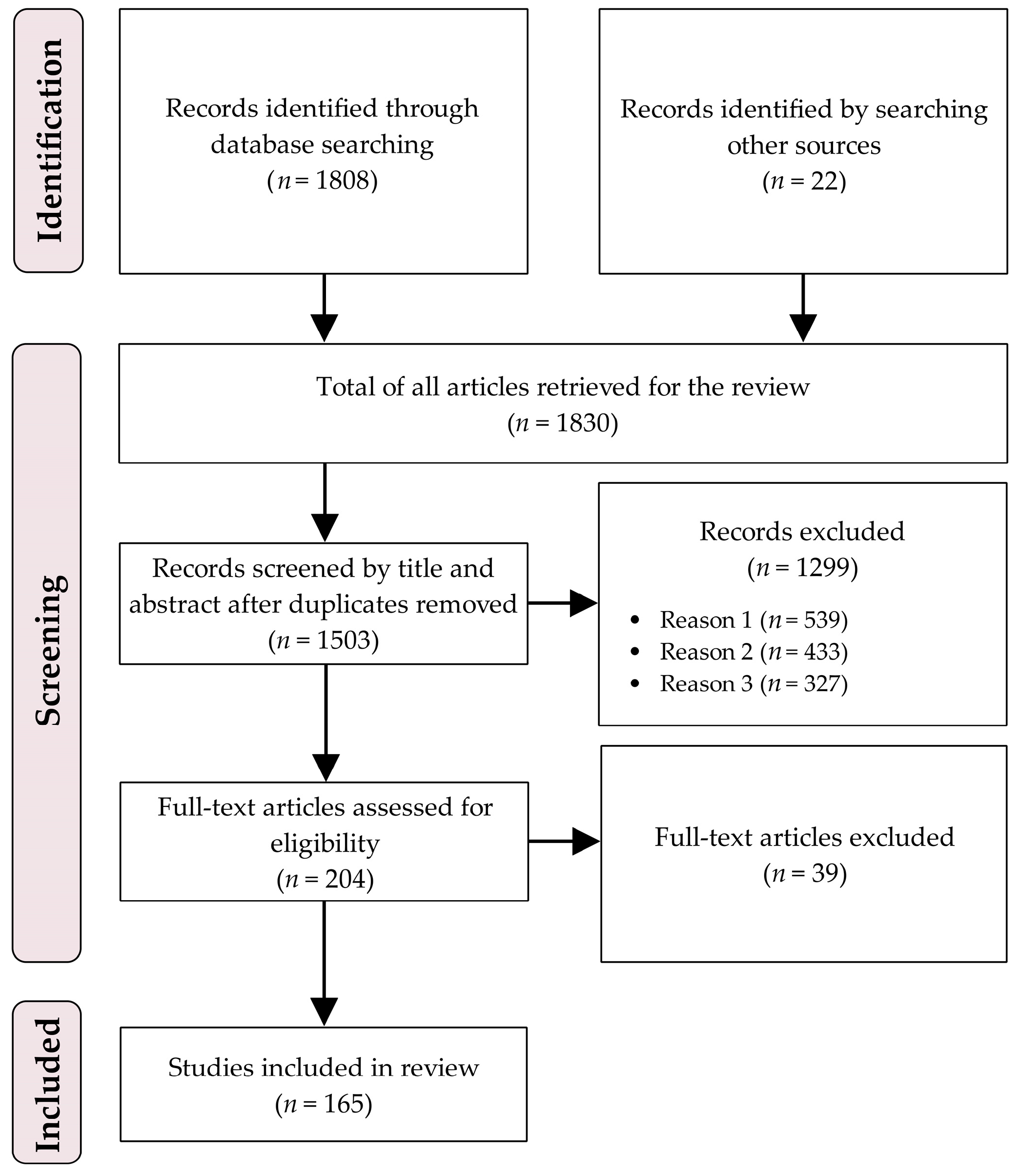
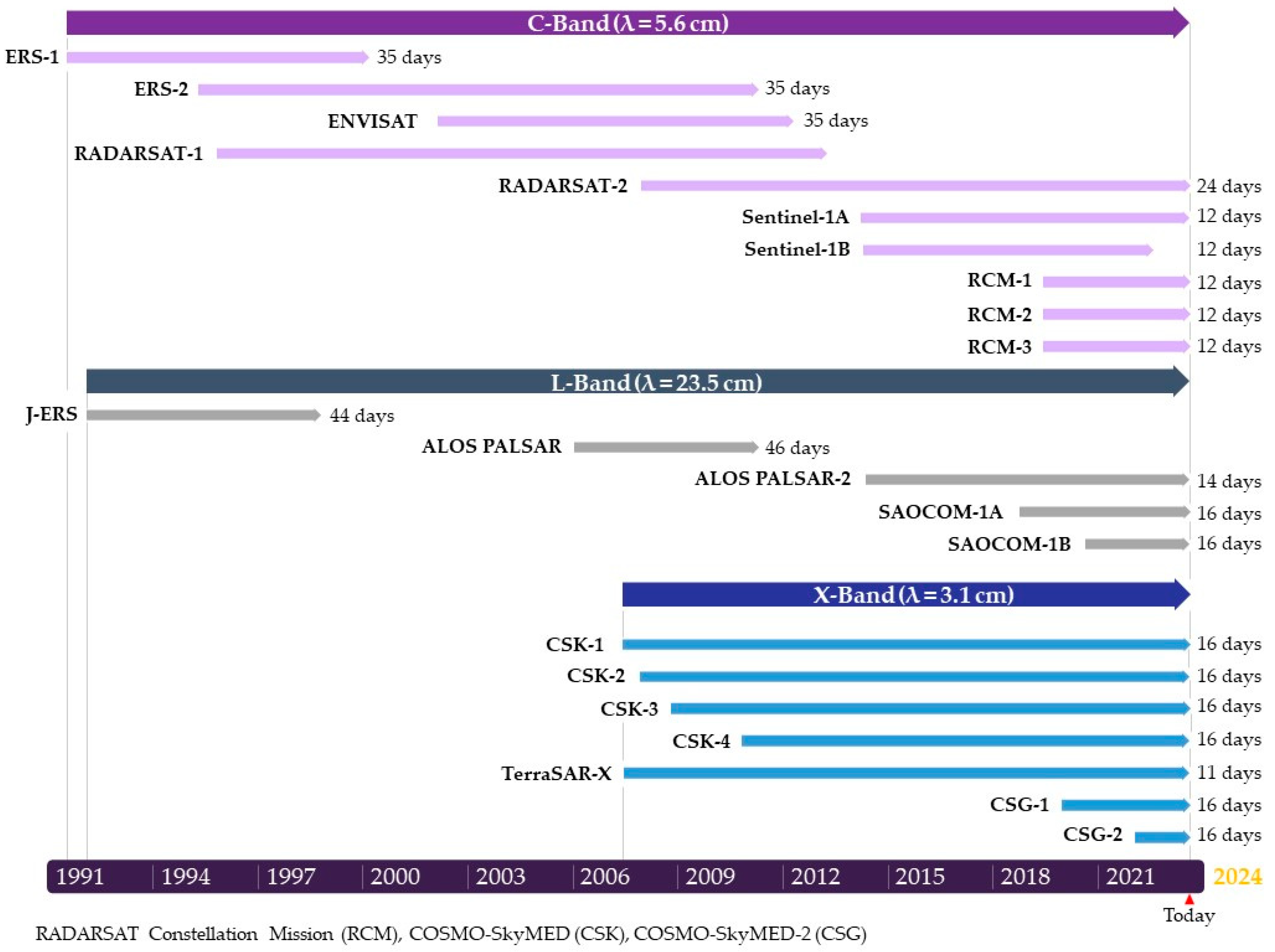



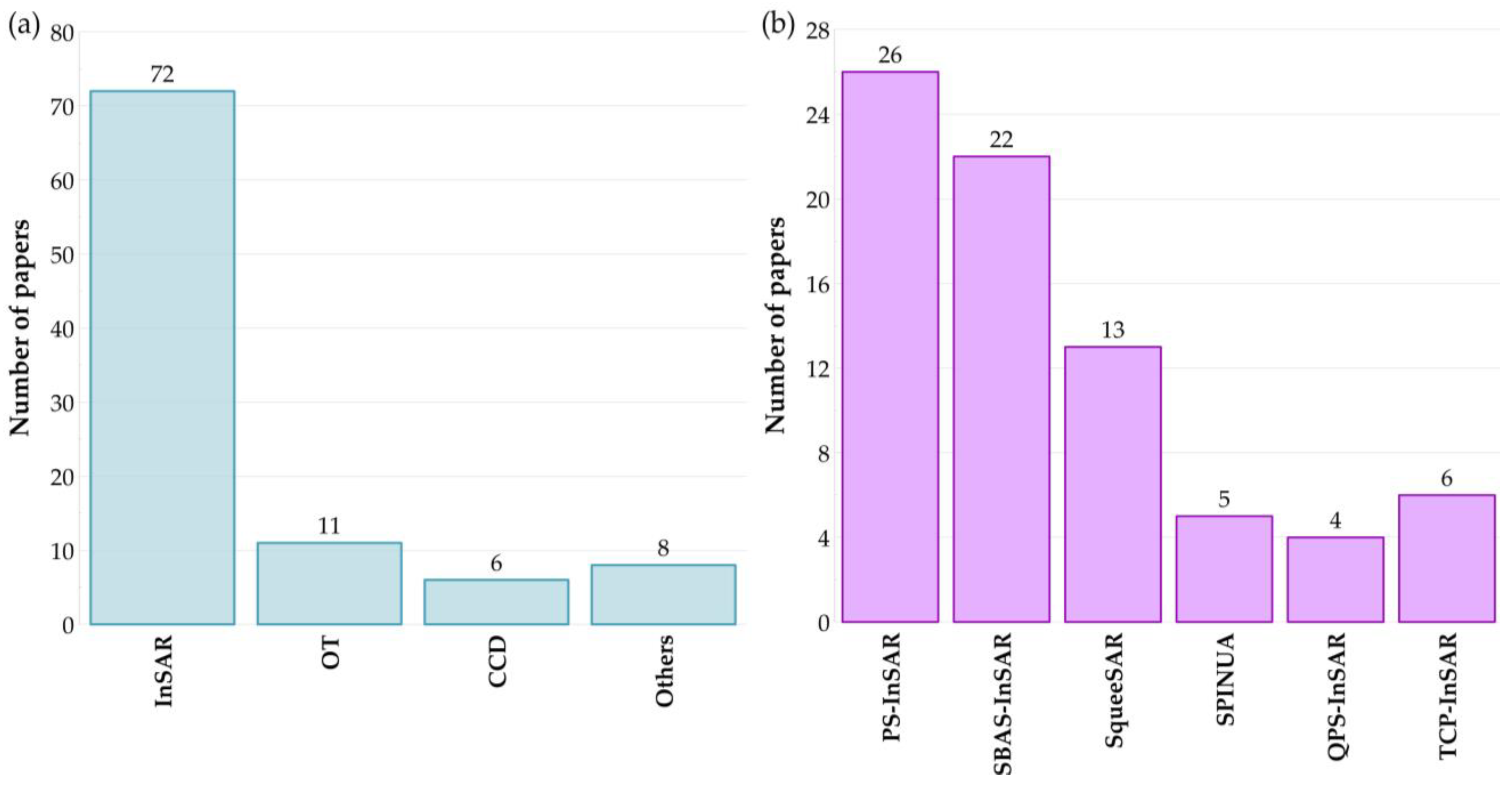
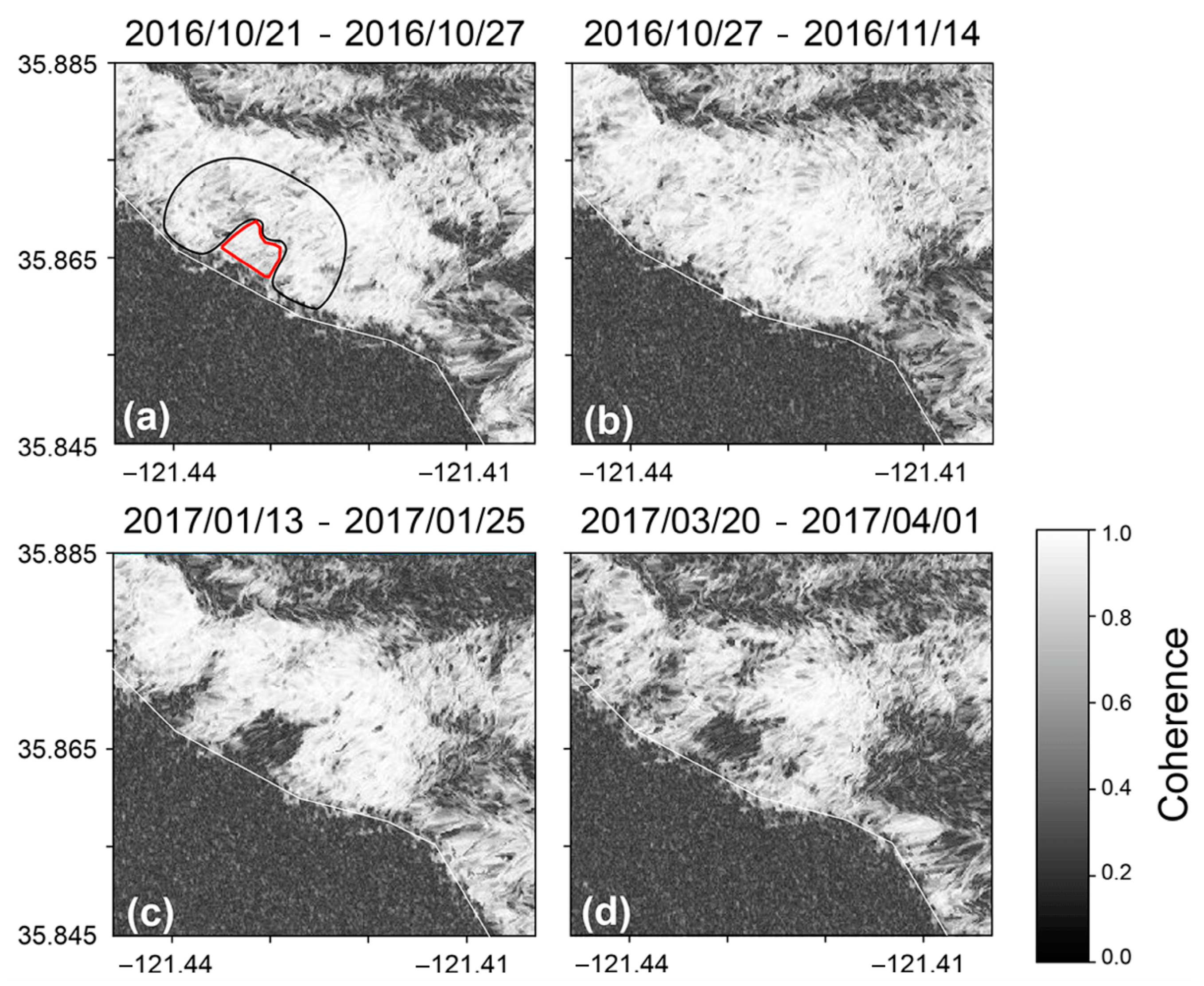
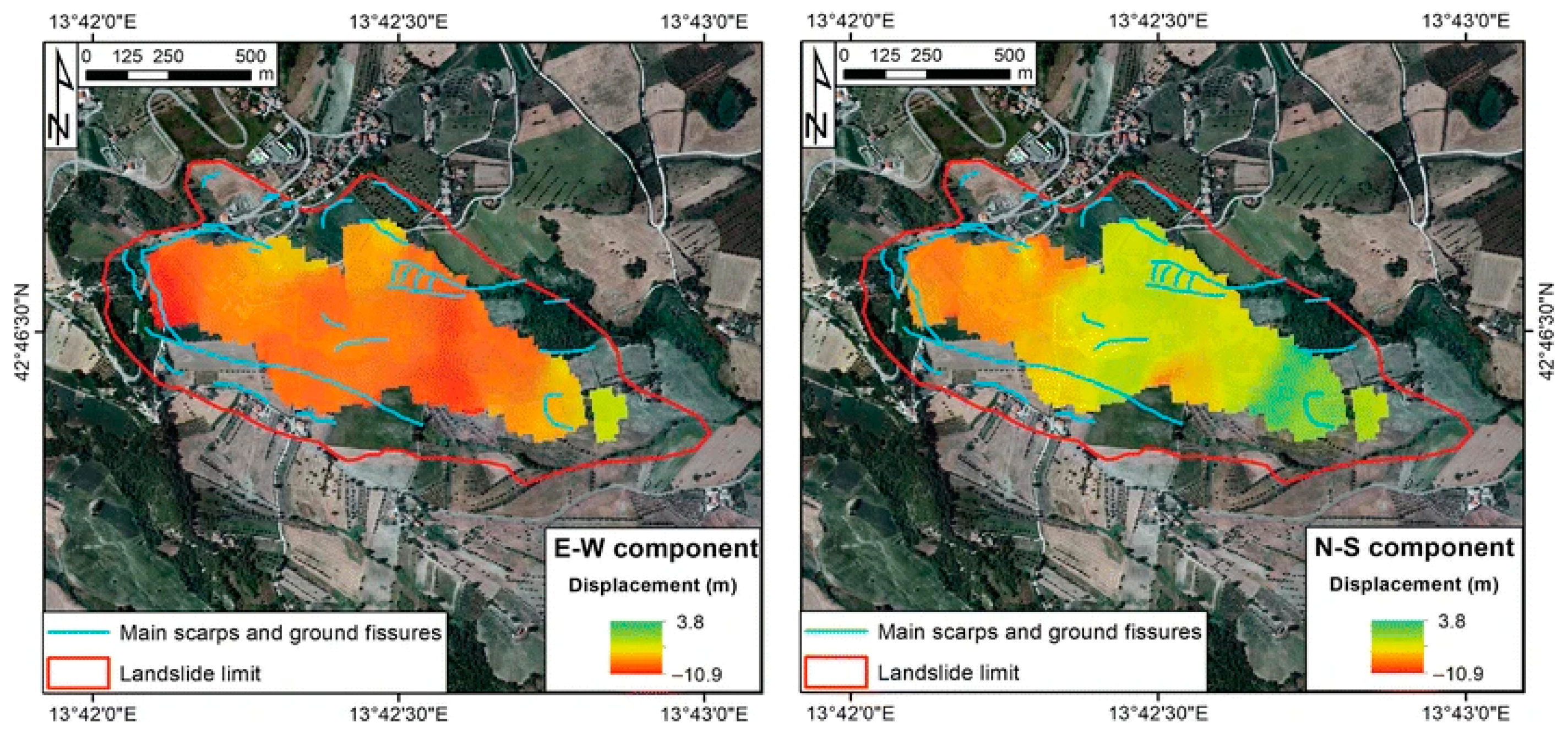
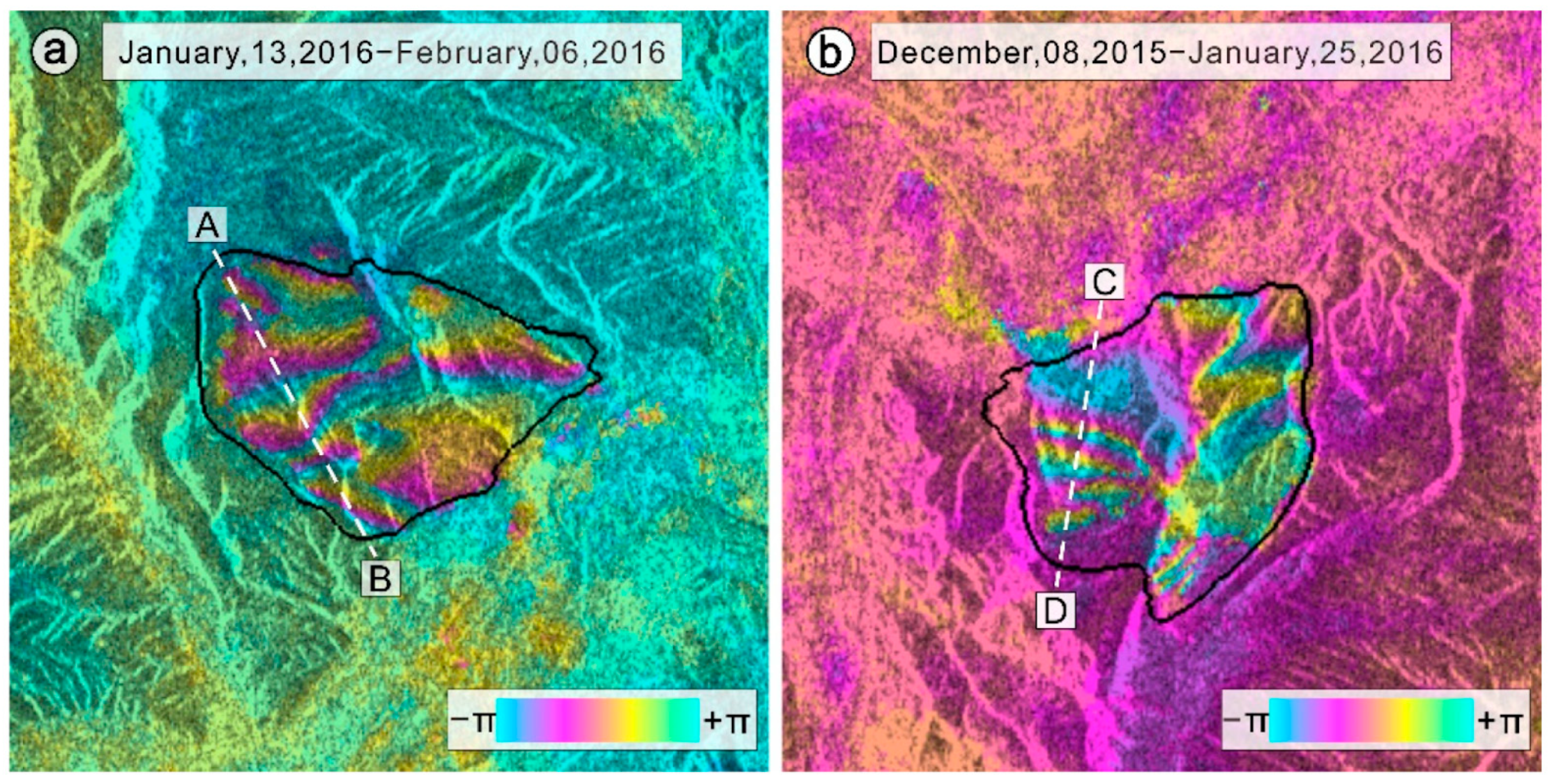
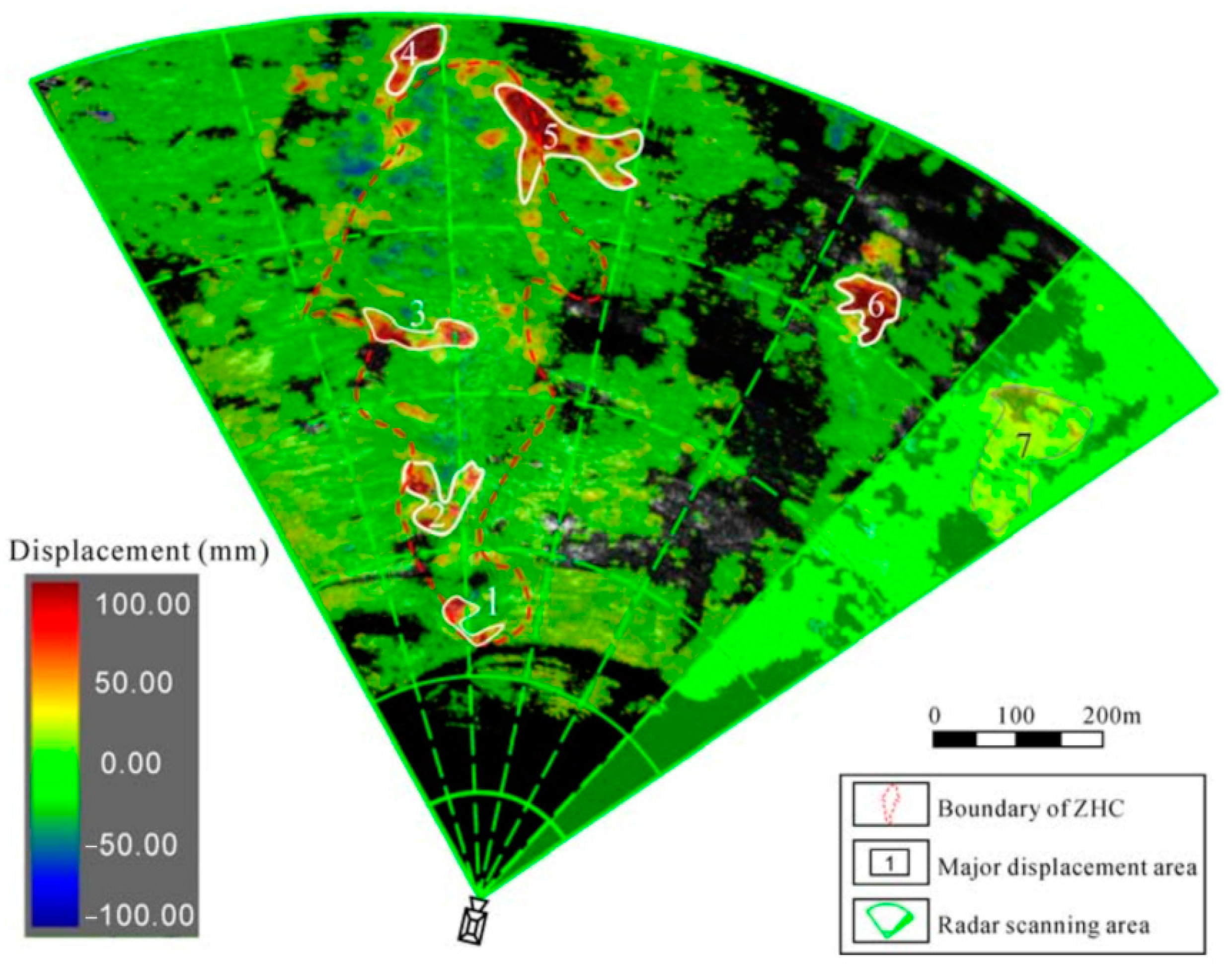
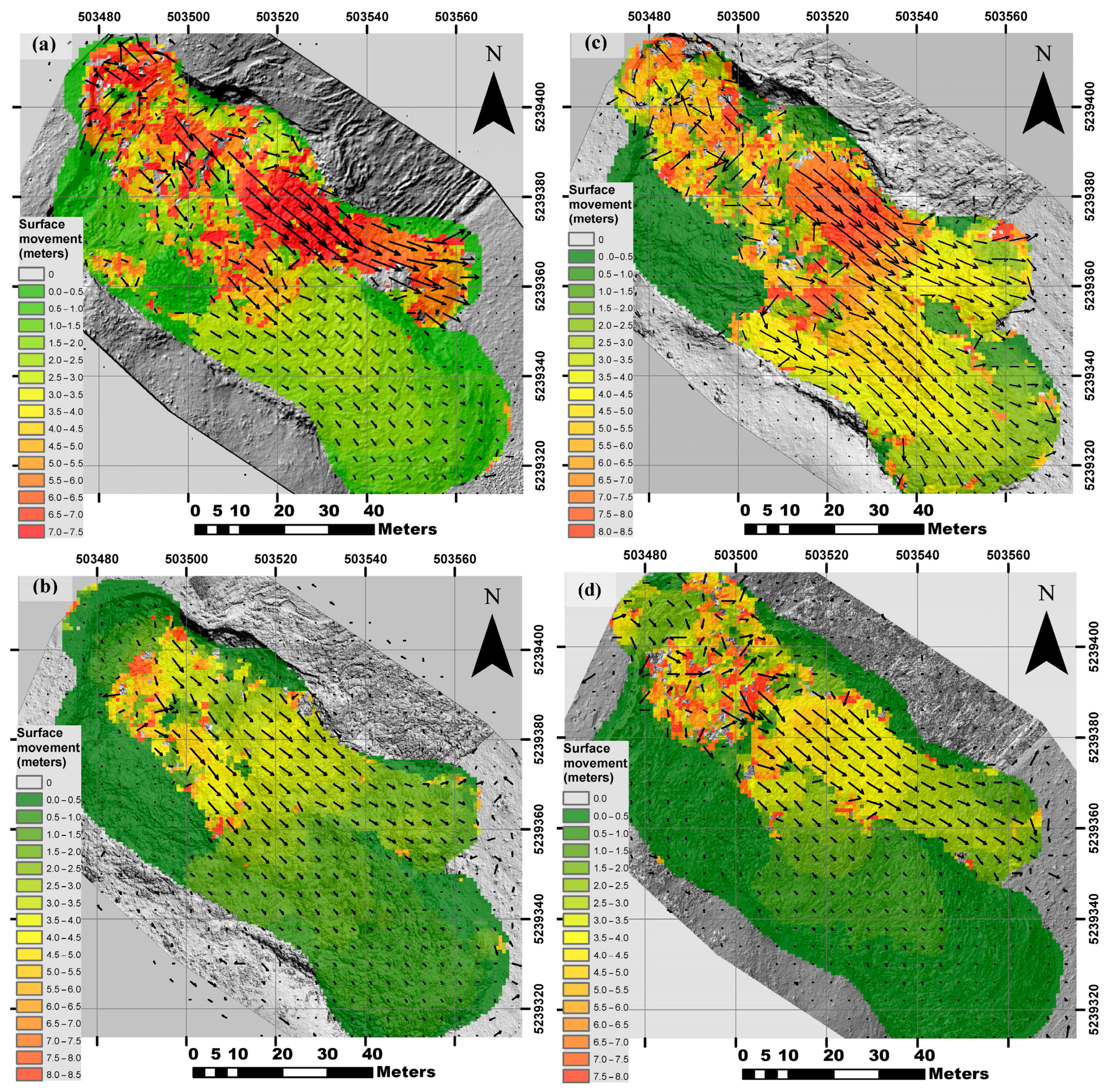
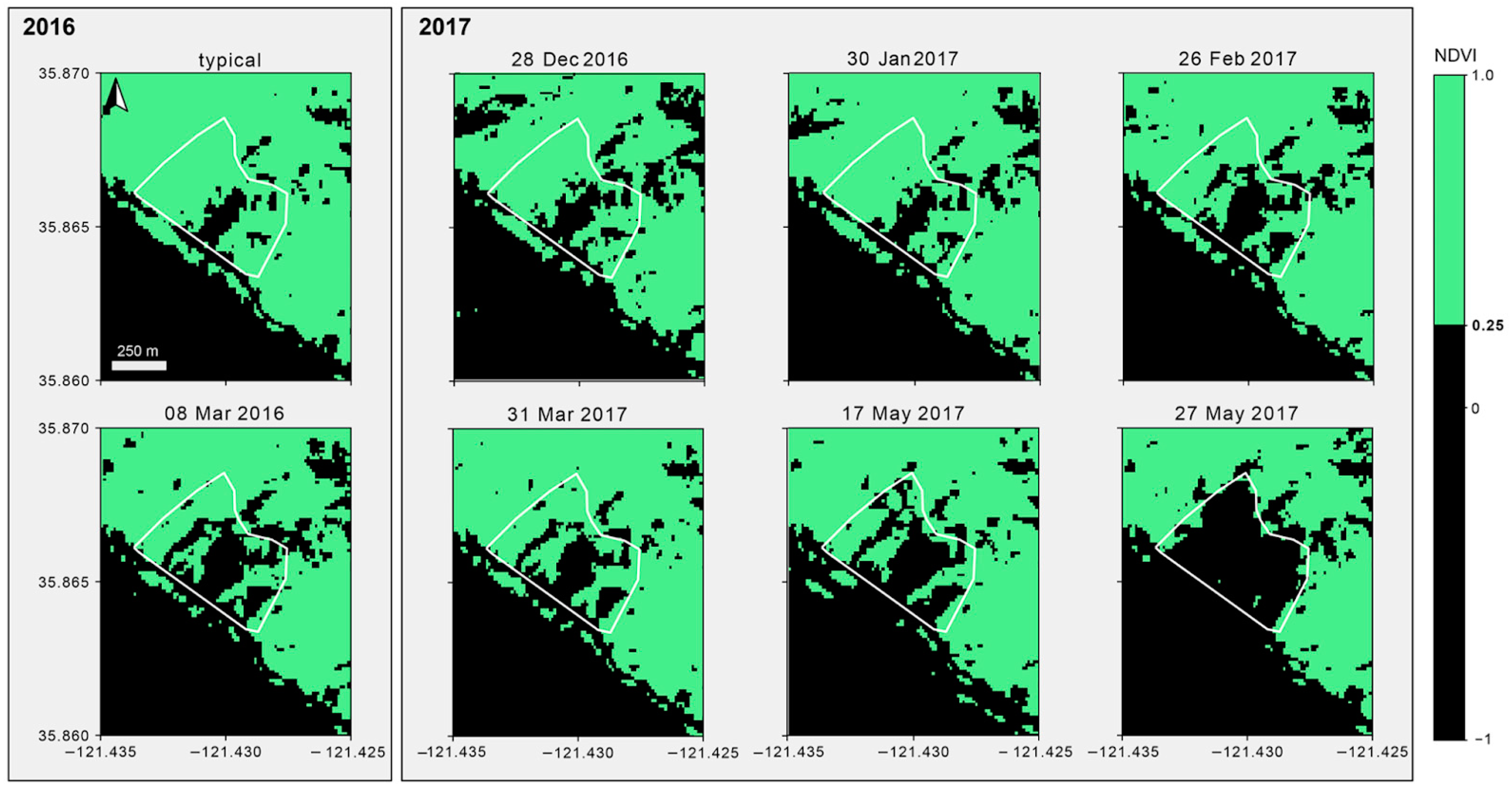

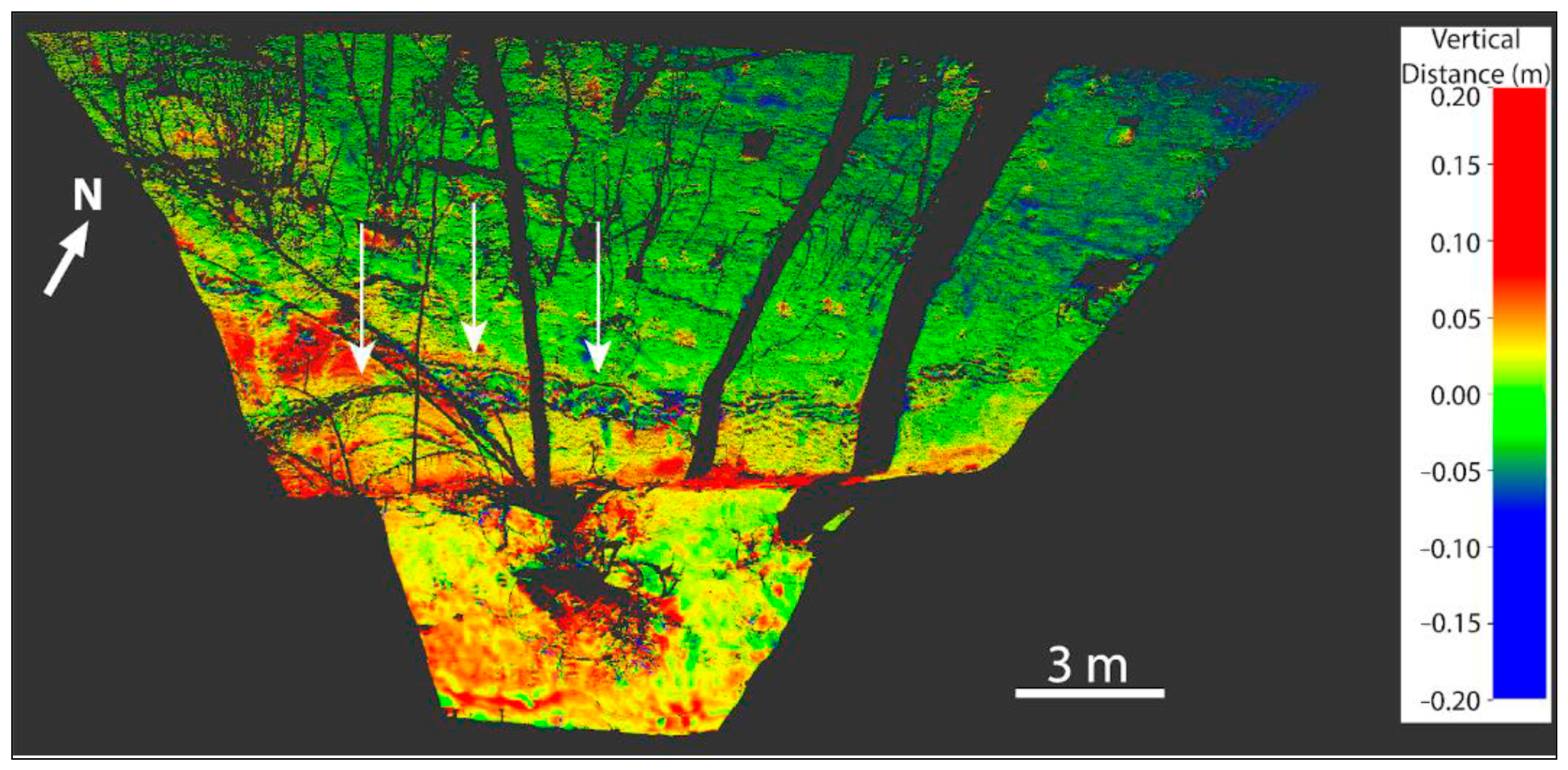
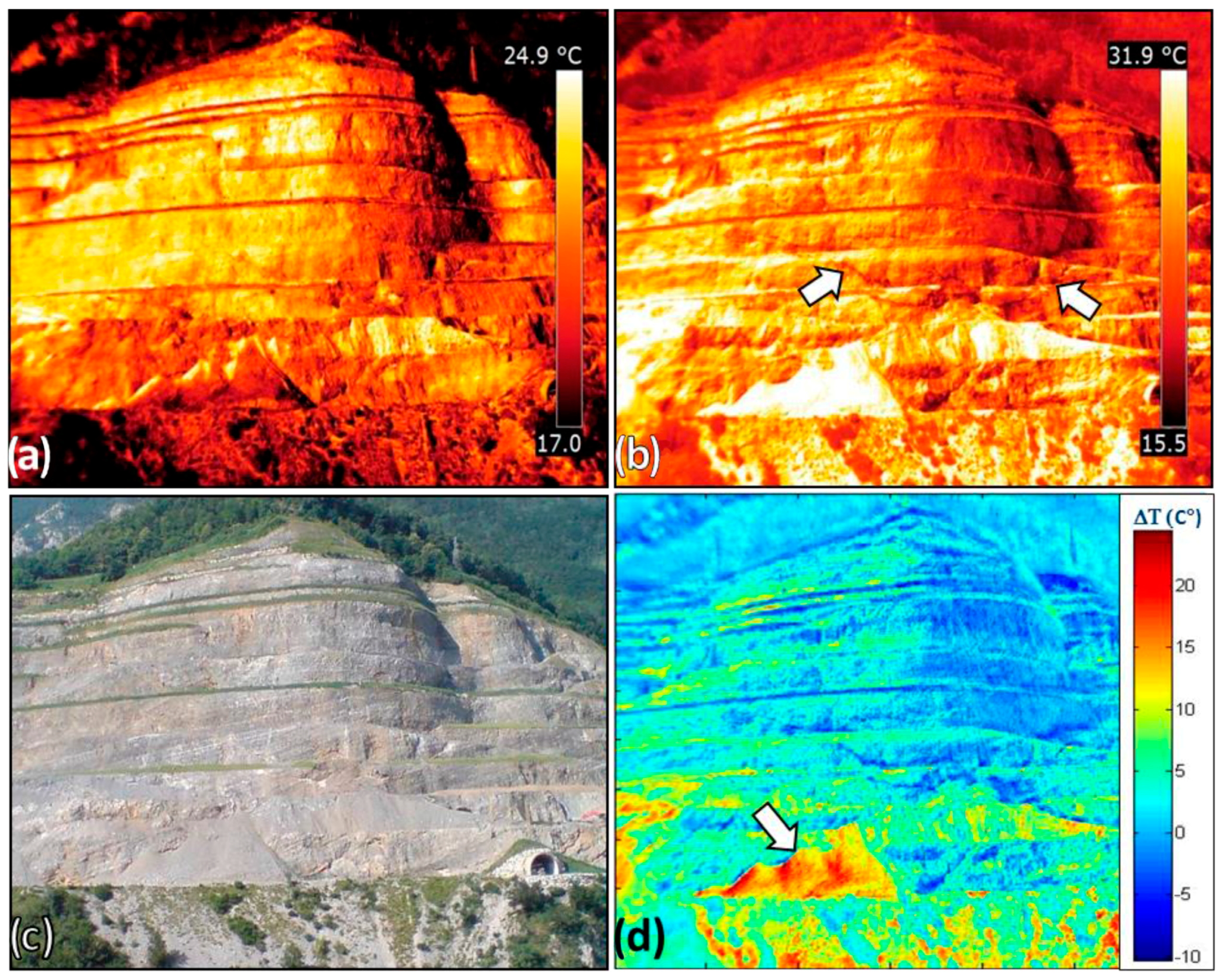
| RST | Sensor | Example | Spatial Resolution | Standard Scene Size |
|---|---|---|---|---|
| SAR | Satellite radar | Sentinel-1 | Range: 1.5 m Azimuth: 3.6 m | 80.1 × 80.1 km |
| TerraSAR-X | Range: 0.24 m Azimuth: 0.6 m | 4 × 3.7 km | ||
| ALOS-2 | Range: 3.0 m Azimuth: 1.0 m | 25 × 25 km | ||
| GB-InSAR | Ground-based radar | FMCW | Range: 0.75 m Azimuth: 1.5 m | 2 × 2 km |
| Optical images | Optical satellite sensor | WorldView-3 | PAN band: 0.31 m | 13.1 × 13.1 km |
| Optical aircraft sensor | Leica RC-30 | 5 cm (500 AGL) | 10 × 10 km | |
| Digital camera on UAV | Zenmuse P1 | ~1 cm (75 AGL) | 2 × 2 km | |
| Multispectral/Hyperspectral images | Multispectral satellite sensor | Sentinel-2 | 10/20/60 * m | 100 × 100 km |
| PlanetScope | 3 m | 20 × 20 km | ||
| Multispectral camera on UAV | MicaSense RedEdge-P | ~5 cm (70 AGL) | 2 × 2 km | |
| LiDAR | Aerial laser scanner | Riegl miniVUX-3UAV | 5 mm (100 AGL) | 2 × 2 km |
| Terrestrial laser scanner | RIEGL VZ-400i | 1 mm (distance of 100 m) | 800 m | |
| IRT | Thermal camera on UAV | Zenmuse H20 Series | ~2 cm (75 AGL) | 2 × 2 km |
| Handheld IR camera | Flir SC620 | ~6 cm (distance of 100 m) | 80 × 60 m |
| RST | Precursor Type | ||
|---|---|---|---|
| SAR | CCD | Figure 7 | |
| OT | Figure 8 | ||
| InSAR | Figure 9 | ||
| GB-InSAR | Figure 10 | ||
| Optical images | Figure 11 | ||
| Multispectral/Hyperspectral images |
| Figure 12 | |
| LiDAR | ALS | Figure 13 | |
| TLS | Figure 14 | ||
| IRT | Figure 15 | ||
| Landslide Type | Parameters to Monitoring | Equipment for Monitoring | Monitoring Techniques | Reference |
|---|---|---|---|---|
| Multidisciplinary approaches | ||||
| Rock slides | Displacement, Deformation, Volume calculations, Inclination, Rainfall, Temperature | Ground radars, Laser scanners, UAVs, GNSS receivers, Cameras, DMS instrumentations, Extensometers, Tiltmeters, Rain gauges, Thermometers | GB-InSAR, LiDAR (ALS, TLS), UAV photogrammetry (3D modeling analysis), GNSS measurement, Deformation analysis, Geotechnical measurements using extensometers and tiltmeters, Rainfall monitoring, Temperature monitoring in boreholes and modeling | [132] |
| Rock slides | Displacement, Deformation, Rainfall, Crack features | Radar satellites, UAVs, GNSS receivers, Crack meters, Rain gauges | InSAR, UAV photogrammetry (3D modeling analysis), GNSS measurement, Geotechnical measurements using a crack meter, Rainfall monitoring | [133] |
| Translational slides | Displacement, Inclination | Radar satellites, Inclinometers | InSAR (PS-InSAR, DS-InSAR), Geotechnical measurements using inclinometer | [134] |
| Earth flows | Displacement, Deformation, Detecting the sub-surface structure of landslides, The distribution of hydrological characteristics and reconstructing the landslide body | Radar and optical satellites, Laser scanners, Multi-electrode resistivity meters | InSAR (SBAS-InSAR), Optical image analysis, TLS (3D modeling analysis), Geophysics measurements using ERT | [135] |
| Rock slides | Displacement, Vibration | Radar and optical satellites, Seismic stations | InSAR (D-InSAR), Optical images and DEM analysis, Monitoring seismic activity | [136] |
| Lateral spread | Displacement, Deformation, Inclination | Radar satellites, UAVs, GNSS receivers, Extensometers, Tiltmeters | InSAR (PS-InSAR), UAV photogrammetry (3D modeling analysis), GNSS measurement, Geotechnical measurements using extensometers and tiltmeters | [137] |
| Deep-seated landslides | Displacement, Deformation, Atmospheric conditions, Groundwater level, Visual change detection | Radar satellites, Ground radars, UAVs, Automatic weather stations (AWSs), Wireless networks, Camera systems (PICSs) | Mobile techniques: InSAR (SBAS-InSAR), GB-InSAR, UAV photogrammetry (3D modeling analysis, orthomosaic analysis), Permanent techniques: Meteorological data analysis, Groundwater level measurements, Optical images analysis | [138] |
| Slow moving landslides | Displacement, Deformation, Inclination, Rainfall | Radar satellites, Inclinometers, Extensometers, Rain gauges | InSAR (PS-InSAR), Geotechnical measurements using inclinometer and extensometers, Rainfall monitoring | [139] |
| Remote Sensing approaches | ||||
| Flows | Displacement, Deformation, Change detection | Radar and optical satellites, UAVs | InSAR, Optical images and aerial images analysis | [50] |
| Different types of landslides | Displacement, Deformation, Creep | Radar and optical satellites, UAVs | InSAR, Optical images and aerial images analysis | [20] |
| Rockfalls, Rock slides | Displacement, Deformation, Temperature | Ground radars, Laser scanners, Thermal cameras | GB-InSAR, TLS (point cloud and 3D modeling analysis), IRT (temperature map analysis) | [58] |
| Mud flows | Displacement, Coherence change detection, Vegetation index, Rainfall, Temperature | Radar and optical satellites, Rain gauges, Thermometers | InSAR (NSBAS—the new small baseline subset), CCD, Multispectral images, Rainfall and temperature monitoring | [109] |
| Rockfalls | Displacement, Deformation | Radar satellites, Ground radars, Laser scanners | InSAR (PS-InSAR), GB-InSAR, TLS (3D modeling analysis) | [108] |
| Translational slides | Displacement, Deformation | Radar satellites, Ground radars | InSAR (PS-InSAR), GB-InSAR | [140] |
| Earth flows | Displacement, Deformation, Change detection | Radar satellites, UAVs | InSAR (SBAS-InSAR), UAV photogrammetry (3D modeling analysis, orthomosaic analysis) | [141] |
| Different type of landslides | Displacement, Deformation, Change detection | Radar and optical satellites, UAVs, Ground radars, Laser scanners | InSAR (D-InSAR, PS-InSAR), GB-InSAR, Optical image analysis, 3D modeling analysis, LiDAR (DEM analysis), UAV photogrammetry (orthomosaic analysis) | [142] |
| Rock slides | Displacement, Deformation | Ground radars, Laser scanners, UAVs | GB-InSAR, TLS (3D modeling analysis), UAV photogrammetry (orthomosaic analysis) | [143] |
| Debris flows | Displacement | Optical satellites, UAVs | Optical images and orthomosaic analysis | [144] |
| RST | Sensors for Monitoring | Landslide Type | Advantages | Limitations | ||||
|---|---|---|---|---|---|---|---|---|
| SAR | CCD | Satellites with radar sensors |
|
|
| |||
| OT |
| |||||||
| InSAR |
| |||||||
| GB-InSAR | Ground-based radars |
|
| |||||
| Optical images | Satellites, UAVs with digital cameras |
| ||||||
| Multispectral (MS)/Hyperspectral images | Satellites/UAVs with multispectral/hyperspectral sensors |
| ||||||
| LiDAR | TLS | Aircraft with laser scanners, Terrestrial laser scanners |
|
|
| |||
| ALS |
| |||||||
| IRT | Satellites/UAVs with thermographic cameras |
| ||||||
Disclaimer/Publisher’s Note: The statements, opinions and data contained in all publications are solely those of the individual author(s) and contributor(s) and not of MDPI and/or the editor(s). MDPI and/or the editor(s) disclaim responsibility for any injury to people or property resulting from any ideas, methods, instructions or products referred to in the content. |
© 2024 by the authors. Licensee MDPI, Basel, Switzerland. This article is an open access article distributed under the terms and conditions of the Creative Commons Attribution (CC BY) license (https://creativecommons.org/licenses/by/4.0/).
Share and Cite
Strząbała, K.; Ćwiąkała, P.; Puniach, E. Identification of Landslide Precursors for Early Warning of Hazards with Remote Sensing. Remote Sens. 2024, 16, 2781. https://doi.org/10.3390/rs16152781
Strząbała K, Ćwiąkała P, Puniach E. Identification of Landslide Precursors for Early Warning of Hazards with Remote Sensing. Remote Sensing. 2024; 16(15):2781. https://doi.org/10.3390/rs16152781
Chicago/Turabian StyleStrząbała, Katarzyna, Paweł Ćwiąkała, and Edyta Puniach. 2024. "Identification of Landslide Precursors for Early Warning of Hazards with Remote Sensing" Remote Sensing 16, no. 15: 2781. https://doi.org/10.3390/rs16152781





